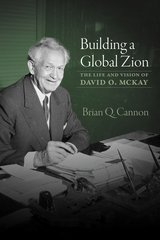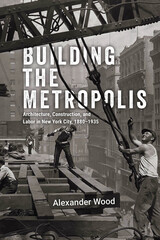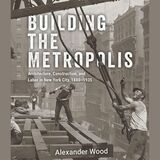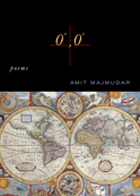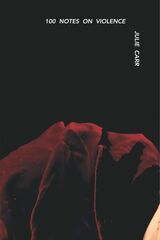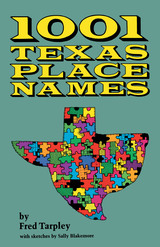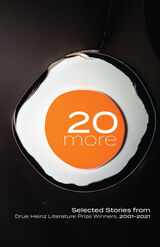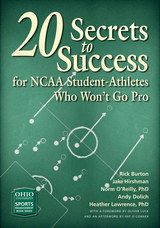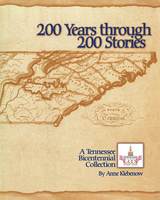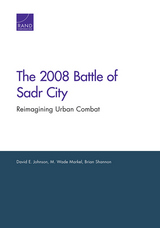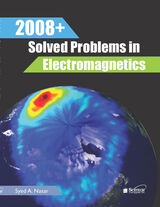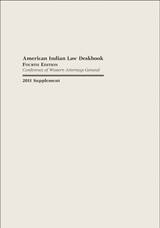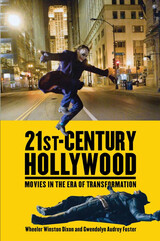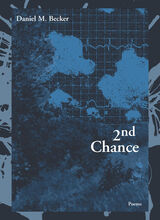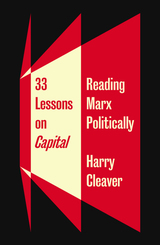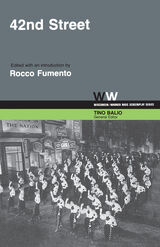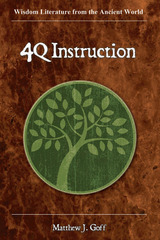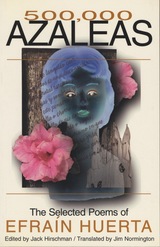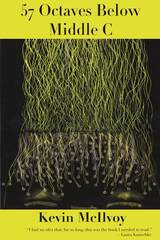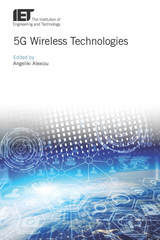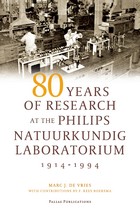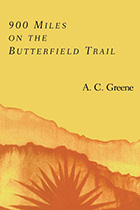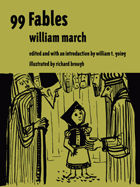0°, 0°: Poems
Amit Majmudar
Northwestern University Press, 2009 0° , 0° is where the equator and prime meridian cross, but it is also, in Amit Majmudar’s poetic cartography, "the one True Cross, the rood’s wood warped and tacked / pole to pole." Unlikely intersections lie at the heart of Amit Majmudar's first collection of poetry. Mythical, biblical, political, and scientific allusion thrive side by side, inspiring surprise and wonder. Majmudar’s training as a medical doctor is clearly at work as he is able to balance poetic forms requiring surgical precision—including the exceedingly difficult ghazal—with warmth and compassion for the world. Majmudar understands suffering on the large scale and the small, whether he is speaking up for the biblical character Job and "answering the whirlwind," or tallying the human cost of war at Walter Reed Army Medical Center.
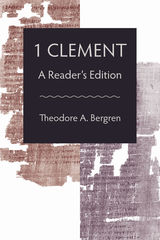 1 Clement: A Reader's Edition
Theodore A. Bergren
Catholic University of America Press, 2020 The present volume is a "reader's edition" of 1 Clement, an important early Christian epistolary writing in Greek that probably dates from the late first century CE. The volume is designed for rapid reading and for classroom use. On each left-facing page is printed a running, sequential section of the Greek text. Next to that, on each right-facing page, are recorded all of the more unusual words in that section of Greek text, with dictionary form, part of speech, and definition(s). All of the more common words in that same section of Greek text are included in a comprehensive glossary at the end of the book.
This system, then, is designed so that the reader of the Greek text will not have to stop to look up every unusual Greek word in a printed or online dictionary. He or she will simply have to look to the facing page. Such constant lookups in a printed or online dictionary are tedious and time-consuming, and have little pedagogical value. Since in the present edition the words recorded on the right-facing page are not parsed, the reader is still faced with the challenge of parsing the word and determining its place in the overall structure of the sentence. It is this process that does serve a useful pedagogical purpose, and the present system preserves the challenge of this process.
The introduction to the volume covers (1) 1 Clement’s genre, date, setting in life, purpose, sources, and main themes; (2) the compositional outline of the book; (3) the book’s authorship, history of reception, and textual attestation; (4) discussion of the present “reader’s edition”; (5) a list of scriptural quotations and allusions; and (6) a comprehensive bibliography on the text of 1 Clement.
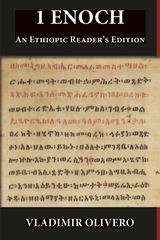 1 Enoch: An Ethiopic Reader’s Edition
Vladimir Olivero
SBL Press, 2025 The book of 1 Enoch is one of the most remarkable literary products of Second Temple Judaism. Attributed to Enoch, the great-grandfather of Noah, the text provides details about how some early Jews understood the cosmos, angels, the corruption of humanity, and coming judgment. Despite 1 Enoch’s importance for understanding early Jewish and Christian eschatology, its complicated textual history has left the work largely inaccessible in its original languages. With the tools provided in this volume, Vladimir Olivero takes intermediate students of Ethiopic through 1 Enoch in one of its primary languages, Ge‘ez. Students not only gain greater facility in language but prepare themselves for more advanced textual study of this important text across its various witnesses. This unique, user-friendly guide introduces readers to 1 Enoch’s linguistic features. Olivero parses all the verbs and provides English glosses for the verbs and nouns that appear in 1 Enoch. A convenient lexicon and concordance at the end of the volume provide the range of translations available for each word occurring in 1 Enoch and a list of passages in which the term occurs. This volume is perfect for independent learning, classroom settings, or as a refresher to Classical Ethiopic.
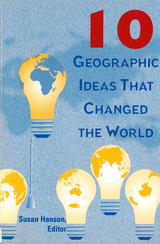 10 Geographic Ideas That Changed the World
Hanson, Susan
Rutgers University Press, 1997 When geographic ideas change the world in our heads, the impact can be read on the ground and in our lives. In these thought-provoking, witty essays, some of America's most distinguished geographers explore ten geographic ideas that have literally changed the world and the way we think and act. They tackle ideas that impose shape on the world, ideas that mold our understanding of the natural environment, and ideas that establish relationships between people and places. Every one of these ideas has had--and continues to have—a deep effect on the way we understand the world and our place in it. A compelling introduction to the discipline of geography, this colleciton will change the way you look at both geography and the world!
The contributors, who include several past presidents of the Association of American Geographers, members of the National Academy of Sciences, and authors of major works in the discipline, are: Elizabeth K. Burns, Patricia Gober, Anne Godlewska, Michael F. Goodchild, Susan Hanson, Robert W. Kates, John R. Mather, William B. Meyer, Mark Monmonier, Edward Relph, Edward J. Taaffe, and B. L. Turner, II.
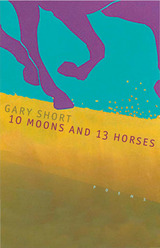 10 Moons And 13 Horses: Poems
Gary Short
University of Nevada Press, 2004 Gary Short’s new collection is the work of a mature poet at the peak of his powers, confident of his ability to speak of human betrayal and the fragility of life without bitterness or cheap sentiment, to find poignancy in loss and exaltation in the outwardly mundane. His voice is lyrical, tough, and capable of touching us profoundly.
Short knows Nevada’s austere landscape, its ephemeral beauty, and its stoic people as few writers in any genre do. He also understands the complexities of the human soul and the contradictions of love. So he tells of how his mother, dying of cancer, revisits a day thirty years in the past when her sons trapped a trout and kept it in their father’s horse trough and how now, in her mind’s eye, she carries the boxed-in fish to the stream to release it, “a moment/of having, not loss.” And of how the feathers of a dead owl in a long-dead oak tree have blown loose, “caught and leafed out/from each taloned twig and limb . . . each feather/a separate flight, shining to live.” This is rich and wondrous poetry, deeply moving, unforgettable.
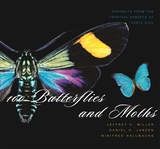 100 Butterflies and Moths: Portraits from the Tropical Forests of Costa Rica
Jeffrey C. Miller, Daniel H. Janzen, and Winifred Hallwachs
Harvard University Press, 2007 Walking a forest trail in Costa Rica, a visitor might be struck by the sight of an iridescent blue morpho butterfly fluttering ahead in the filtered daylight, or an enormous silk moth, as magnificently patterned and subtly colored as a Persian carpet, only emerging to fly at night. Elsewhere, vivid yellow and orange sulphur butterflies flock to puddles to sip the concentrated minerals. Such is the dazzling variety of the butterflies and moths unique to this region.
Gathered by biologists Daniel Janzen and Winifred Hallwachs in the forests of northwestern Costa Rica, 100 tropical butterflies and moths represent the diversity in large-format photographs by Jeffrey Miller that document the dizzying variety of shapes, colors, and markings. The photographs are accompanied by species accounts and images of the corresponding caterpillar. The authors recount these insects' feats of mimicry and migration, lift the veil on their courtship, and show how the new technology of DNA barcoding is changing the picture of Lepidopteran biodiversity.
The authors also tell the success story of Area de Conservacion Guanacaste, where the long-term work of Janzen and Hallwachs, a team of caterpillar collectors, and the participation of neighboring farming communities has deepened understanding of Costa Rica's Lepidoptera and has brought about advances in restoration ecology of tropical habitats, biodiversity prospecting, biotechnology, and ecotourism development.
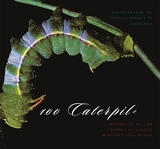 100 Caterpillars: Portraits from the Tropical Forests of Costa Rica
Jeffrey C. Miller, Daniel H. Janzen, and Winifred Hallwachs
Harvard University Press, 2006 Every bright monarch butterfly or striking luna moth started out in a far subtler form of nature's mosaic, a humble caterpillar. It is this early stage of life--crafted by natural selection into machines for converting a vast array of plant matter, mostly leaves, into the beautiful adults that have captivated humans for millennia--that this book brings to dazzling light. Unobtrusive as they go about their business, these caterpillars are rarely seen by humans--and are virtually never seen from the perspective presented in this sumptuous volume: photographed in extreme close-ups at a resolution that captures in sharp detail the exquisite colors and features eluding the casual observer.
Gathered by biologists Daniel Janzen, Winifred Hallwachs, and Jeffrey Miller in the tropical dry forests, cloud forests, and rain forests of northwestern Costa Rica, over 100 large-format photographs of caterpillars document the dizzying variety of shapes, vivid colors, and cryptic markings among these species. The pictures are accompanied by capsule species accounts--revealing life histories as diverse as their forms--and magnificent images of the adult butterfly or moth. Throughout, the authors convey an intimate sense of these creatures--studied over twenty-five years--by focusing on how their features figure in their behavior and ecology, and on the beauty of nature in this life stage, as well as the nature of that beauty.
The story of the caterpillars is also the success story of Area de Conservacion Guanacaste--where the long-term work of Janzen and Hallwachs, and a team of gusaneros (caterpillar collectors and rearers), along with the participation of neighboring farming communities, has deepened understanding of Costa Rica's Lepidoptera and has brought about advances in restoration ecology of tropical habitats, biodiversity prospecting, biological control of pests, biotechnology, residents' bioliteracy, and ecotourism development.
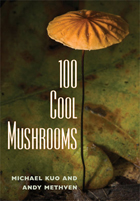 100 Cool Mushrooms
Michael Kuo and Andy Methven
University of Michigan Press, 2010 All mushrooms are cool, but the ones discussed in 100 Cool Mushrooms are especially cool. Authors Michael Kuo and Andy Methven cover a broad spectrum of notable North American mushrooms: from common fungi that are widely distributed and frequently found, to rare mushrooms that are not found in field guides; from the beautiful to the ugly (and even disgusting). Each is described and shown, including its ecology and physical features. Inside, you'll find mushrooms such as:
Phallus rubicundus, a stinkhorn that in certain areas appears to be spreading on wood chips sold as commercial mulch. Now you might just find it in your backyard.
Cordyceps militaris, a little orange club fungus that grows in insects, then explodes from their bodies.
Piptoporus betulinus, a mushroom commonly found on birch trees, was found carefully packed in the belongings of the Tyrolean Iceman. Archaeologists speculate that he used it for medicinal purposes.
. . . and 97 more! Dr. Michael Kuo, the principal developer of MushroomExpert.Com, is an English teacher in Illinois and an amateur mycologist. He is the author of Morels and 100 Edible Mushrooms. Dr. Andrew Methven is Professor of Mycology and Chair of the Biology Department at Eastern Illinois University.
 100 Details
Kenneth Clark
Harvard University Press, 1990 100 Details offers Kenneth Clark's personal choice of details of paintings in the National Gallery, London, and his responses to them. Clark chooses the pictures he likes best, hoping that we will come to like them too. The result is like taking a stroll through a glorious art collection with a critic of astounding eye and intellect at our side.
First published in 1938, the book is arranged in a series of facing page spreads, now reproduced in full color, enabling us to discern analogies and contrasts between painting that are rarely seen together--a faun from Piero di Cosimo, a satyr from Rubens. The running commentaries are Kenneth Clark at his best. They range from a few lines to an entire history of still life between Giotto and Picasso, all conveyed in easy style.
Clark insists that there are countless ways of enjoying paintings, provided we stop, look, and think. He has picked the ones to stop at: the detail makes us look. And his comments, wide in scope and catholic in approach, suggest lines of thought so diverse that it is inconceivable that none will strike a chord with the reader.
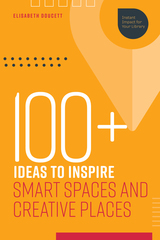 100+ Ideas to Inspire Smart Spaces and Creative Places
Elisabeth Doucett
American Library Association, 2020 The ideas in this book are all about helping your library building become a more exciting, interesting, experiential space where people are engaged and want to spend time. More time spent in the library increases the library’s value and relevance to its users—and the more intriguing the space is, the more it helps draw in new patrons. Taking inspiration and examples from companies and non-profits outside the library world, this book’s engaging ideas include - using “biophilic design” to bring nature into your library through gardens, plants, and greenery;
- transforming static spaces into “Instagram bait”;
- putting art installations in bathrooms;
- turning underutilized spaces like hallways and mezzanines into welcoming “chill” zones;
- creating pop-ups and other flexible spaces that change regularly;
- developing co-working spaces in libraries;
- preserving and promoting silent spaces; and
- creating “parklets” from parking spaces.
Complete with lists of additional resources for discovering even more ideas, this book will help all kinds of libraries create innovative spaces that will delight their communities.
100 Notes on Violence
Julie Carr
Omnidawn, 2022 Back in print, Carr’s powerful poems seek out and face violence and its counterforces.
Julie Carr obsessively researches instances of intimate terrorism, looking everywhere from Walt Whitman and Emily Dickinson to lists of phobias and weapon-store catalogs. She searches for what can be learned from the statistics, the statements by and about rapists and killers, the websites of hate groups, and the capacity for cruelty that lies within all of us. 100 Notes on Violence is a diary, a document, and a dream log of the violence that grips America and devastates so many. But Carr also offers a layered and lyric tribute to violence’s counterforces: love, commonality, and care. Her unflinching “notes” provoke our minds and burrow into our emotions, leading us to confront our fears and our own complicity.
100 Words: Poems
Damon Potter and Truong Tran
Omnidawn, 2021 Written as a conversation, 100 Words is an exchange of ideas, dialogues, burdens, and ideals between someone White and someone Brown. Two poets, Damon Potter and Truong Tran, write to each other about one hundred powerful words—like “proximity, “shame,” and “hope”—each of which is an abstraction rife with socially inscribed beliefs and denials. They turn to each other in an exchange, a negotiation, and a series of discoveries as they write of their individual histories, share their burdens, and learn to carry weight together.
Tran explains this project, saying “it is occurring to me even as I am writing this now that this is not an experiment, or case study or collaboration or partnership. Damon is not the subject nor am I. This is a shared endeavor, a lived experience between two very different lives trying to understand what it means to be, to see the other.”
 100 Years of Archaeology at the University of Michigan: Essays on the Past, Present, and Future of the Discipline
Edited by Brian A. Stewart, Robin A. Beck, Tiffany C. Fryer, Michael L. Galaty, Raven Garvey, Hannah Hoover, John O’Shea, and Alicia Ventresca-Miller
University of Michigan Press, 2025 The University of Michigan has been at the forefront of archaeological research for more than 100 years, since 1922, when the Museum of Anthropology (now the Museum of Anthropological Archaeology) was established on the Ann Arbor campus. The goal of its curators for many decades was to create a research and teaching program that emphasized methodological rigor in the analysis of archaeological materials, attempting to solve grand questions about human behavior through fieldwork, collections, and laboratory work. About fifty years ago, the Museum's emphasis shifted to developing archaeological theory when a new generation of curators with processualist leanings made Ann Arbor a testing ground for the so-called New Archaeology.
Now, archaeology stands at a crossroads. Some archaeologists refer to the death of archaeological theory. Others stake out opposed camps of generalists and particularists. At U-M, as at many other universities, the past decade has seen a new commitment to collaborative archaeology, working with descendant communities and acknowledging the discipline's roots in colonialism and extraction.
In 2022, to celebrate a century of existence, the University of Michigan Museum of Anthropological Archaeology (UMMAA) hosted an international conference to explore possibilities for a middle way: an archaeology for the next 100 years, combining humanistic and scientific approaches, which allows for both agents and systems, description and explanation, science and heritage. This volume is meant to be a snapshot of that conference and this moment in the development of the discipline. Included are most of the papers and posters presented, as well as photographs of the panels and the proceedings.
 100 Years of Kurt Weill, Volume 30
Tom Sellar, ed.
Duke University Press The year 2000 marks the hundredth birthday of theater and opera composer Kurt Weill (1900-1950). In celebration of this occasion, 100 Years of Kurt Weill features recently rediscovered and previously untranslated dramatic works by Weill and critical essays and articles reflecting on his legacy and influence. Reviews and reports on centenary productions from around the world are included along with panel discussions by directors and musicians on Weill’s cultural identity.
100 Years of Kurt Weill makes a notable addition to the commemoration of the anniversary with the English-language publication of two major Weill librettos, both translated and introduced by international opera director Jonathan Eaton. Written in 1925, Royal Palace is a one-act opera with a libretto by surrealist/expressionist poet-playwright Yvan Goll. It was one of the first operas to incorporate film. The other work, Die Bürgschaft (The Pledge), was inspired by a dark social parable by Johann Gottfried von Herder and written in collaboration with Caspar Neher. The piece was banned in 1933 by the Nazi regime because of its controversial content and was not restaged in its original form until Eaton’s 1998 and 1999 productions in Bielefeld, Germany, and at the Spoleto Festival U.S.A.
This special issue specifically addresses the theatrical context of Weill’s music, exploring new perspectives on the artist and his work and on recent developments in Weill scholarship. These articles, combined with the previously unpublished works, make 100 Years of Kurt Weill a considerable and unique contribution to the centenary commemoration of his birth.
 100 Years of Permanent Revolution: Results and Prospects
Edited by Bill Dunn and Hugo Radice
Pluto Press, 2006 One hundred years after their first appearance in Leon Trotsky's Results and Prospects, this book critically reevaluates two key Marxist theories: uneven and combined development, and permanent revolution. It brings together a formidable array of Marxist intellectuals from across the world including Daniel Bensaid, Michael Löwy, Hillel Ticktin and Patrick Bond. Marx saw societies progressing through distinct historical stages feudal, bourgeois and communist. Trotsky advanced this model by considering how countries at different stages of development influence each other. Developed countries colonise less developed countries and exploit their people and resources. Elsewhere, even as many were kept in poverty, the influence of foreign capital and state-led industrialisation produced novel economic forms and prospects for political alliances and change. The contributors show how, 100 years on from its original publication, Trotsky's theories are hugely useful for understanding today's globalised economy, dominated by US imperialism. The book makes an ideal introduction to Trosky's thinking, and is ideal for students of political theory and development economics.
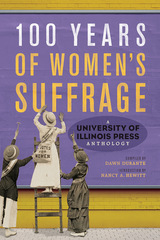 100 Years of Women's Suffrage: A University of Illinois Press Anthology
Compiled by Dawn Durante. Introduction by Nancy A. Hewitt
University of Illinois Press, 2019 100 Years of Women’s Suffrage commemorates the centennial of the Nineteenth Amendment by bringing together essential scholarship on the women's suffrage movement and women's voting previously published by the University of Illinois Press. With an original introduction by Nancy A. Hewitt, the volume illuminates the lives and work of key figures while uncovering the endeavors of all women—across lines of gender, race, class, religion, and ethnicity—to gain, and use, the vote. Beginning with works that focus on cultural and political suffrage battles, the chapters then look past 1920 at how women won, wielded, and continue to fight for access to the ballot. A curation of important scholarship on a pivotal historical moment, 100 Years of Women’s Suffrage captures the complex and enduring struggle for fair and equal voting rights. Contributors: Laura L. Behling, Erin Cassese, Mary Chapman, M. Margaret Conway, Carolyn Daniels, Bonnie Thornton Dill, Ellen Carol DuBois, Julie A. Gallagher, Barbara Green, Nancy A. Hewitt, Leonie Huddy, Kimberly Jensen, Mary-Kate Lizotte, Lady Constance Lytton, and Andrea G. Radke-Moss
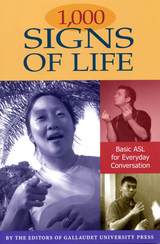 1,000 Signs of Life: Basic ASL for Everyday Conversation
The Editors of Gallaudet University Press
Gallaudet University Press, 2004 Here’s the succinct handbook that will allow everyone to enjoy the beauty and functionality of American Sign Language. 1,000 Signs of Life: Basic ASL for Everyday Conversation illustrates a potpourri of intriguing and entertaining signs that can be grasped quickly and used to communicate with anyone familiar with ASL, deaf or hearing. Organized alphabetically in 17 categories, this handy paperback offers common signs for animals, food, clothes, people, health and body, the time, days of the week, seasons, colors, quantities, transportation and travel, and many more practical topics. Readers also can learn signs for community-related terms, holidays and religion, and for thoughts and emotions, signs that will offer them the opportunity to experience the full potential of ASL.
1,000 Signs of Life begins with a concise introduction to American Sign Language, including how it evolved and how its grammar and syntax work. Complementing this information are categories on signs for adjectives and adverbs, prepositions and locations, question words, and verbs and action words. Interspersed throughout the text are tips for signing, rules of signing etiquette, and engaging anecdotes about Deaf culture, Deaf people, and the Deaf community. 1,000 Signs of Life provides a fun, fast way to learn basic ASL signs and also offers easy-to-follow instructions and hints on how to use them in a variety of everyday situations. It's the perfect streamlined guide for signing ASL.
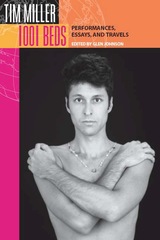 1001 Beds: Performances, Essays, and Travels
Tim Miller; Edited by Glen Johnson
University of Wisconsin Press, 2006 For a quarter century, Tim Miller has worked at the intersection of performance, politics, and identity, using his personal experiences to create entertaining but pointed explorations of life as a gay American man—from the perils and joys of sex and relationships to the struggles of political disenfranchisement and artistic censorship. This intimate autobiographical collage of Miller's professional and personal life reveals one of the celebrated creators of a crucial contemporary art form and a tireless advocate for the American dream of political equality for all citizens.
Here we have the most complete Miller yet—a raucous collection of his performance scripts, essays, interviews, journal entries, and photographs, as well as his most recent stage piece Us. This volume brings together the personal, communal, and national political strands that interweave through his work from its beginnings and ultimately define Miller's place as a contemporary artist, activist, and gay man.
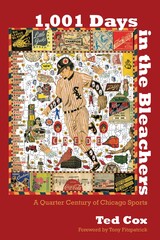 1,001 Days in the Bleachers: A Quarter Century of Chicago Sports
Ted Cox
Northwestern University Press, 2013 Loyal sports fans follow their teams through peaks and valleys, but in no other city have fans experienced the highs and lows of Chicagoans in the past generation. This collection of Ted Cox’s greatest hits writing "The Sports Section" for the Chicago Reader from 1983 to 2008 constitutes an intimate history of Chicago teams during these years. From the triumphs—the six titles won by the Bulls, the Super Bowl champion 1985 Bears, and the White Sox winning the World Series in 2005—to the regularly occurring collapses of the Cubs, Cox puts his audience on the scene. He evokes the fan’s experience with a level of vivid detail now nearly extinct from sports journalism. Cox writes like an ordinary observer who just happens to have excellent seats and easy access to the players and coaches. 1,001 Days in the Bleachers stands not only as a chronicle of Chicago’s teams but also as a portrait of the evolution of professional sports and their place in the life of the city.
 1001 Most Asked Questions American West
Harry E. Chrisman
Ohio University Press, 1982 During his more than 40 years of newspaper and magazine work, Harry Chrisman has been answering questions about the American West — both the standard and the oddball queries, such as "What is the most fantastic bear story you ever heard?"
Chrisman first encountered many of these questions in his monthly column "Roundup Time," which appeared in The West, a national monthly magazine.
Concentrating on the puzzlers, Chrisman has gathered in his illustrated volume over one thousand of the most frequently asked questions about the American West. Readers will find chapters devoted to the people of the West (cowboys, Indians, lawmen, outlaws, and gunfighters), chapters on the Western lifestyle (culture, pioneer life, folklore, and business and commerce), as well as chapters on the land (geography and geology, and towns and territories).
Here, then, is an entertaining volume to which readers can turn for information and recreation and which will remain a constant source for the younger generations who wish to learn of their forefathers and of the many problems they encountered and resolved during the settlement of the Great American West.
1001 Texas Place Names
By Fred Tarpley
University of Texas Press, 1980 From Notrees to Pine Island, from Scotland to Moscow, from Dickens to Tennyson, from Spur to Lariat, from Buck Naked to Bald Prairie—Texans are unsurpassed for the imaginative names they give their towns and cities. Fred Tarpley has chosen 1001 of the most unusual and interesting of the 75,000 place names that dot the Texas map.
The names of Texas communities and places can be traced to a number of basic sources, including people; landscapes; the Bible; literature and mythology; misunderstandings and errors; backward spellings and blends; and anecdotes and events. Each entry in 1001 Texas Place Names gives the official spelling of the name, phonetic pronunciation where necessary, dates of post office operation, and a short narrative about the origin of the name and the history of the place. Each of Texas's 254 counties is represented by at least two entries.
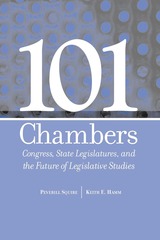 101 CHAMBERS: CONGRESS, STATE LEGISLATURES, & THE FUTURE OF LEGISLATIVE STUDIES
Peverill Squire and Keith E. Hamm
Ohio State University Press, 2005 Although legislative studies is thriving, it suffers from one glaring weakness: a lack of truly comparative, cross-institutional research. Instead, research focuses overwhelmingly on the U.S. Congress. This unfortunate fixation limits the way scholars approach the testing of many compelling theories of legislative organization and behavior, and it ignores the invaluable research possibilities that comparison with the 99 American state legislative chambers offers. State legislatures are easily compared to Congress: They arise out of the same political culture and history. Their members represent the same parties and face the same voters in the same elections using the same rules. And the functions and roles are the same, with each fully capable of initiating, debating, and passing legislation. None of the methodological problems found when comparing presidential system legislatures with parliamentary system legislatures arise when comparing Congress and the state legislatures. However, while there are great similarities, there are also important differences that provide scholars leverage for rigorously testing theories. The book compares and contrasts Congress and the state legislatures on histories, fundamental structures, institutional and organizational characteristics, and members. By highlighting the vast array of organizational schemes and behavioral patterns evidenced in state legislatures, the authors demonstrate that the potential for the study of American legislatures, as opposed to the separate efforts of Congressional and state legislative scholars, is too great to leave unexplored.
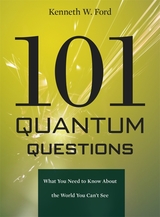 101 Quantum Questions: What You Need to Know About the World You Can't See
Kenneth W. Ford
Harvard University Press, 2012 Ken Ford’s mission is to help us understand the “great ideas” of quantum physics—ideas such as wave-particle duality, the uncertainty principle, superposition, and conservation. These fundamental concepts provide the structure for 101 Quantum Questions, an authoritative yet engaging book for the general reader in which every question and answer brings out one or more basic features of the mysterious world of the quantum—the physics of the very small.
Nuclear researcher and master teacher, Ford covers everything from quarks, quantum jumps, and what causes stars to shine, to practical applications ranging from lasers and superconductors to light-emitting diodes. Ford’s lively answers are enriched by Paul Hewitt's drawings, numerous photos of physicists, and anecdotes, many from Ford’s own experience. Organized for cover-to-cover reading, 101 Quantum Questions also is great for browsing.
Some books focus on a single subject such as the standard model of particles, or string theory, or fusion energy. This book touches all those topics and more, showing us that disparate natural phenomena, as well as a host of manmade inventions, can be understood in terms of a few key ideas. Yet Ford does not give us simplistic explanations. He assumes a serious reader wanting to gain real understanding of the essentials of quantum physics.
Ken Ford's other books include The Quantum World: Quantum Physics for Everyone (Harvard 2004), which Esquire magazine recommended as the best way to gain an understanding of quantum physics. Ford's new book, a sequel to the earlier one, makes the quantum world even more accessible.
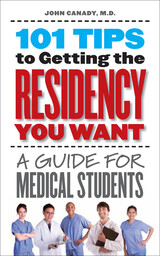 101 Tips to Getting the Residency You Want: A Guide for Medical Students
John Canady, M.D.
University of Iowa Press, 2008 Each year, more than 15,000 U.S. medical students—along with more than 18,000 graduates of foreign medical schools and schools of osteopathic medicine—take part in the National Residency Matching Program, vying for a small number of positions in the United States. In this keenly competitive environment, they seek every advantage they can get. Based on more than two decades of experience preparing candidates for residency programs, John Canady has developed a concise practical guide to making one’s way through the maze of residency applications and interviews. Guiding residency applicants past the pitfalls in all aspects of the process, 101 Tips to Getting the Residency You Want includes sections on tried-and-true methods for senior year planning, the importance of networking, tips for interviewing, practical advice for carefree travel, and guidelines for follow-up to out-of-town rotations and interviews. This guide covers the do’s and don’ts that will maximize each applicant’s chances and exposes the common blunders that can ruin an application in spite of the best grades and test scores.
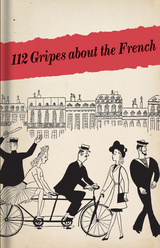 112 Gripes about the French: The 1945 Handbook for American GIs in Occupied France
Edited by the Bodleian Library
Bodleian Library Publishing, 2013 When American troops arrived in Paris at the end of World War II, they were at first welcomed by the local population. However, the French soon began to resent the Americans for their brashness and display of wealth, while the Americans found the French and their habits equally irritating and incomprehensible: they bathed too little, drank too much, and were almost unfailingly unfriendly.
To bridge the cultural divide, the War Department commissioned humorist Leo Rosten to write this surprisingly candid guide that paired common complaints about the French with answers aimed at promoting understanding. From the fascinations of French nightlife to Gallic grooming and fashions, the guide sought to correct the misconceptions behind a litany of common complaints: Laissez-faire is not in fact a call to laziness, and the French do not play checkers in cafés all day—though they do extol the virtues of a leisurely lunch. The moral principles of the Frenchwoman ought not to be drawn from the few one might find loitering on the fringes of the camp.
Beyond their intended instructive purposes, the grievances included in the guide are at times as revealing of the preconceptions of the American servicemen as they are of the French, as well as offering fascinating insight into the details of daily life immediately after the war, including the acute poverty, the shortage of food and supplies, and the scale of destruction suffered by France during the six years of conflict. Illustrated throughout with charming cartoons and written in a direct, no-nonsense style, 112 Gripes about the French is by turns amusing and thought-provoking in its valiant stand against prejudice and stereotype.
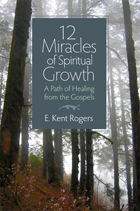 12 Miracles of Spiritual Growth: A Path of Healing from the Gospels
E. Kent Rogers
Swedenborg Foundation Publishers, 2012 Our spiritual wounds and weaknesses, E. Kent Rogers tells us, are truly blessings in disguise. They allow the Lord to enter our hearts and work through us, revealing his healing power to all.
In this practical guide to healing our inner selves, Rogers takes the reader on a journey through twelve of Jesus’s miracles from the Gospels, examining the lessons that each can teach us. From the story of the Canaanite’s daughter (healing from feelings of unworthiness) through the miracle of the resurrection of Lazarus (finding spiritual rebirth), Jesus’s miracles trace a path of spiritual growth that is as powerful today as it was during his lifetime. Written as a guide for group sharing, this book can also be used for personal study. Each chapter concludes with a guided meditation, a summary of the lessons taught by the miracle being discussed, suggested exercises, and questions for discussion or reflection. While the book grew from the author’s experience as a Swedenborgian, it can easily be used by seekers from any faith tradition.
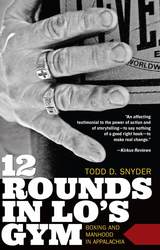 12 Rounds in Lo's Gym: Boxing and Manhood in Appalachia
Todd D. Snyder
West Virginia University Press, 2018 Questions of class and gender in Appalachia have, in the wake of the 2016 presidential election and the runaway success of Hillbilly Elegy, moved to the forefront of national conversations about politics and culture. From Todd Snyder, a first generation college student turned college professor, comes a passionate commentary on these themes in a family memoir set in West Virginia coal country.
12 Rounds in Lo’s Gym is the story of the author’s father, Mike “Lo” Snyder, a fifth generation West Virginia coal miner who opened a series of makeshift boxing gyms with the goal of providing local at-risk youth with the opportunities that eluded his adolescence. Taking these hardscrabble stories as his starting point, Snyder interweaves a history of the region, offering a smart analysis of the costs—both financial and cultural—of an economy built around extractive industries.
Part love letter to Appalachia, part rigorous social critique, readers may find 12 Rounds in Lo’s Gym—and its narrative of individual and community strength in the face of globalism’s headwinds—a welcome corrective to popular narratives that blame those in the region for their troubles.
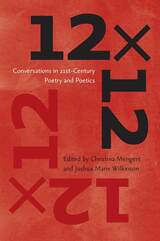 12 x 12: Conversations in 21st-Century Poetry and Poetics
Christina Mengert
University of Iowa Press, 2009 Bringing together penetrating conversations between poets of different generations as they explore process and poetics, poetry’s influence on other art forms, and the political and social aspects of their work, 12 × 12 restores poesis to the center of poetry.
Christina Mengert and Joshua Marie Wilkinson have assembled an expansive and searching view of the world through the eyes of twenty-four of our most vital and engaging poets. Punctuated by poems from each contributor, 12 × 12 brings together an unparalleled range of poets and poetries, men and women from around the world, working poets for whom the form vitally matters.
Contributors
Jennifer K. Dick–Laura Mullen
Jon Woodward–Rae Armantrout
Sabrina Orah Mark–Claudia Rankine
Christina Hawkey–Tomaž Šalamun
Christine Hume–Rosemarie Waldrop
Srinkath Reddy–Mark Levine
Karen Volkman–Allen Grossman
Paul Fattaruso–Dara Wier
Mark Yakich–Mary Leader
Michelle Robinson–Paul Auster
Sawako Nakayasu–Carla Harryman
Ben Lerner–Aaron Kunin
127 Years of Design 1890-2017: The Michigan Daily
Francesca Kielb
Michigan Publishing, 2017 127 Years of Design: The Michigan Daily reveals the visual history of the University of Michigan's student-run newspaper The Michigan Daily’s front page. It analyzes a front page from every decade since 1890, breaking down the evolution of one of the oldest student newspapers in the country. This publication culminates in a focus on today's newspaper design by Francesca Kielb, the recent Managing Design Editor at The Michigan Daily, who completed a total redesign of the paper in celebration of the 125 year history of the publication and of the Bicentennial of The University of Michigan. The book argues that it is essential for contemporary design to look both forward and backwards--to inform our future with our past. A result of nights spent digging through archives and sifting through newspapers, this publication addresses how print has evolved with digitization and technological advancement.
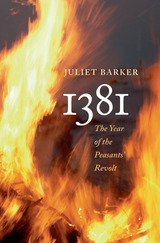 1381: The Year of the Peasants’ Revolt
Juliet Barker
Harvard University Press, 2014 Written with the fluency readers have come to expect from Juliet Barker, 1381: The Year of the Peasants’ Revolt provides an account of the first great popular uprising in England and its background, and paints on a broad canvas a picture of English life in medieval times. Skeptical of contemporary chroniclers’ accounts of events, Barker draws on the judicial sources of the indictments and court proceedings that followed the rebellion. This emphasis offers a fresh perspective on the so-called Peasants’ Revolt and gives depth and texture to the historical narrative. Among the book’s arguments are that the rebels believed they were the loyal subjects of the king acting in his interests, and that the boy-king Richard II sympathized with their grievances.
Barker tells how and why a diverse and unlikely group of ordinary men and women from every corner of England—from servants and laborers living off wages, through the village elite who served as bailiffs, constables, and stewards, to the ranks of the gentry—united in armed rebellion against church and state to demand a radical political agenda. Had it been implemented, this agenda would have transformed English society and anticipated the French Revolution by four hundred years. 1381: The Year of the Peasants’ Revolt is an important reassessment of the uprising and a fascinating, original study of medieval life in England’s towns and countryside.
The 13th Tablet
Alex Mitchell
Haus Publishing Iraq, 2004. Lawlessness is spreading throughout the country and looters have plundered the museums and historical sites. Mina Osman, a young American archaeologist of Iraqi descent, is fighting to preserve the country's antiquities. When she stumbles upon an ancient cuneiform tablet, it proves to be of unimaginable significance: its cryptic language holds a secret that will play a part in a series of earth-shattering events. Aided by ex-US Army Major Jack Hillcliff, Mina travels across the world to unlock the secrets of the 13th Tablet but at each step she is pursued by deadly enemies who will stop at nothing to obtain the tablet and its power for themselves.
1492-1992: Re/Discovering Colonial Writing
Rene Jara and Nicholas Spadaccini, EditorsIntroduction by Rene Jara and Nicholas Spadaccini
University of Minnesota Press, 1991
1492–1992 was first published in 1991. Minnesota Archive Editions uses digital technology to make long-unavailable books once again accessible, and are published unaltered from the original University of Minnesota Press editions.
The essays and documents in this volume underscore the importance of writing as companion of Empire, while at the same time highlighting its subversive power as a series of counter-narratives emerge to contest the tactics and values of the "victors."
Contributors: Rolena Adorno, Tom Conley, Antonio Gomez-Moriana, Beatriz Gonzalez, Rene Jara, Stephanie Merrim, Walter Mignolo, Beatriz Pastor, Jose Rabasa, Nicholas Spadaccini, and Iris Zavala.
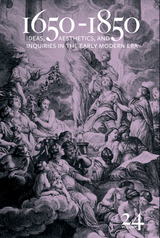 1650-1850: Ideas, Aesthetics, and Inquiries in the Early Modern Era (Volume 24)
Kevin L. Cope
Bucknell University Press, 2019 With issue twenty-four of 1650–1850, this annual enters its second quarter-century with a new publisher, a new look, a new editorial board, and a new commitment to intellectual and artistic exploration. As the diversely inventive essays in this first issue from the Bucknell University Press demonstrate, the energy and open-mindedness that made 1650–1850 a success continue to intensify. This first Bucknell issue includes a special feature that explores the use of sacred space in what was once incautiously called “the age of reason.” A suite of book reviews renews the 1650–1850 legacy of full-length and unbridled evaluation of the best in contemporary Enlightenment scholarship. These lively and informative reviews celebrate the many years that book review editor Baerbel Czennia has served 1650–1850 and also make for an able handoff to Samara Anne Cahill of Nanyang Technological University, who will edit the book review section beginning with our next volume. Most important of all, this issue serves as an invitation to scholars to offer their most creative and thoughtful work for consideration for publication in 1650–1850.
About the annual journal 1650-1850
1650-1850 publishes essays and reviews from and about a wide range of academic disciplines—literature (both in English and other languages), philosophy, art history, history, religion, and science. Interdisciplinary in scope and approach, 1650-1850 emphasizes aesthetic manifestations and applications of ideas, and encourages studies that move between the arts and the sciences—between the “hard” and the “humane” disciplines. The editors encourage proposals for “special features” that bring together five to seven essays on focused themes within its historical range, from the Interregnum to the end of the first generation of Romantic writers. While also being open to more specialized or particular studies that match up with the general themes and goals of the journal, 1650-1850 is in the first instance a journal about the artful presentation of ideas that welcomes good writing from its contributors. First published in 1994, 1650-1850 is currently in its 24th volume. ISSN 1065-3112. Published by Bucknell University Press. Distributed worldwide by Rutgers University Press.
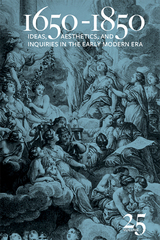 1650-1850: Ideas, Aesthetics, and Inquiries in the Early Modern Era (Volume 25)
Kevin L. Cope
Bucknell University Press, 2020 Volume 25 of 1650–1850: Ideas, Aesthetics, and Inquiries in the Early Modern Era investigates the local textures that make up the whole cloth of the Enlightenment. Ranging from China to Cheltenham and from Spinoza to civil insurrection, volume 25 celebrates the emergence of long-eighteenth-century culture from particularities and prodigies. Unfurling in the folds of this volume is a special feature on playwright, critic, and literary theorist John Dennis. Edited by Claude Willan, the feature returns a major player in eighteenth-century literary culture to his proper role at the center of eighteenth-century politics, art, publishing, and dramaturgy. This celebration of John Dennis mingles with a full company of essays in the character of revealing case studies. Essays on a veritable world of topics—on Enlightenment philosophy in China; on riots as epitomes of Anglo-French relations; on domestic animals as observers; on gothic landscapes; and on prominent literati such as Jonathan Swift, Arthur Murphy, and Samuel Johnson—unveil eye-opening perspectives on a “long” century that prized diversity and that looked for transformative events anywhere, everywhere, all the time. Topping it all off is a full portfolio of reviews evaluating the best books on the literature, philosophy, and the arts of this abundant era.
About the annual journal 1650-1850
1650-1850 publishes essays and reviews from and about a wide range of academic disciplines—literature (both in English and other languages), philosophy, art history, history, religion, and science. Interdisciplinary in scope and approach, 1650-1850 emphasizes aesthetic manifestations and applications of ideas, and encourages studies that move between the arts and the sciences—between the “hard” and the “humane” disciplines. The editors encourage proposals for “special features” that bring together five to seven essays on focused themes within its historical range, from the Interregnum to the end of the first generation of Romantic writers. While also being open to more specialized or particular studies that match up with the general themes and goals of the journal, 1650-1850 is in the first instance a journal about the artful presentation of ideas that welcomes good writing from its contributors.
First published in 1994, 1650-1850 is currently in its 25th volume. ISSN 1065-3112. Published by Bucknell University Press. Distributed worldwide by Rutgers University Press.
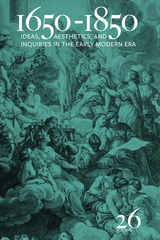 1650-1850: Ideas, Aesthetics, and Inquiries in the Early Modern Era (Volume 26)
Kevin L. Cope
Bucknell University Press, 2021 Volume 26 of 1650–1850: Ideas, Aesthetics, and Inquiries in the Early Modern Era travels beyond the usual discussions of power, identity, and cultural production to visit the purlieus and provinces of Britain’s literary empire. Bulging at its bindings are essays investigating out-of-the-way but influential ensembles, whether female religious enthusiasts, annotators of Maria Edgeworth’s underappreciated works, or modern video-based Islamic super-heroines energized by Mary Wollstonecraft’s irreverance. The global impact of the local is celebrated in studies of the personal pronoun in Samuel Johnson’s political writings and of the outsize role of a difficult old codger in catalyzing the literary career of Charlotte Smith. Headlining a volume that peers into minute details in order to see the outer limits of Enlightenment culture is a special feature on metaphor in long-eighteenth-century poetry and criticism. Five interdisciplinary essays investigate the deep Enlightenment origins of a trope usually associated with the rise of Romanticism. Volume 26 culminates in a rich review section containing fourteen responses to current books on Enlightenment religion, science, literature, philosophy, political science, music, history, and art. About the annual journal 1650-1850
1650-1850 publishes essays and reviews from and about a wide range of academic disciplines: literature (both in English and other languages), philosophy, art history, history, religion, and science. Interdisciplinary in scope and approach, 1650-1850 emphasizes aesthetic manifestations and applications of ideas, and encourages studies that move between the arts and the sciences—between the “hard” and the “humane” disciplines. The editors encourage proposals for special features that bring together five to seven essays on focused themes within its historical range, from the Interregnum to the end of the first generation of Romantic writers. While also being open to more specialized or particular studies that match up with the general themes and goals of the journal, 1650-1850 is in the first instance a journal about the artful presentation of ideas that welcomes good writing from its contributors.
ISSN 1065-3112.
Published by Bucknell University Press. Distributed worldwide by Rutgers University Press.
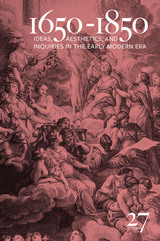 1650-1850: Ideas, Aesthetics, and Inquiries in the Early Modern Era (Volume 27)
Kevin L. Cope
Bucknell University Press, 2022 Rigorously inventive and revelatory in its adventurousness, 1650–1850 opens a forum for the discussion, investigation, and analysis of the full range of long-eighteenth-century writing, thinking, and artistry. Combining fresh considerations of prominent authors and artists with searches for overlooked or offbeat elements of the Enlightenment legacy, 1650–1850 delivers a comprehensive but richly detailed rendering of the first days, the first principles, and the first efforts of modern culture. Its pages open to the works of all nations and language traditions, providing a truly global picture of a period that routinely shattered boundaries. Volume 27 of this long-running journal is no exception to this tradition of focused inclusivity. Readers will travel through a blockbuster special feature on the topic of worldmaking and other worlds—on the Enlightenment zest for the discovery, charting, imagining, and evaluating of new worlds, envisioned worlds, utopian worlds, and worlds of the future. Essays in this enthusiastically extraterritorial offering escort readers through the science-fictional worlds of Lady Cavendish, around European gardens, over the high seas, across the American frontiers, into forests and exotic ecosystems, and, in sum, into the unlimited expanses of the Enlightenment mind. Further enlivening the volume is a cavalcade of full-length book reviews evaluating the latest in eighteenth-century scholarship.
ISSN 1065-3112
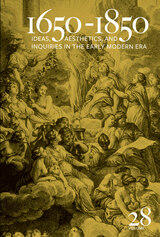 1650-1850: Ideas, Aesthetics, and Inquiries in the Early Modern Era (Volume 28)
Kevin L. Cope
Bucknell University Press, 2023 Rigorously inventive and revelatory in its adventurousness, 1650–1850 opens a forum for the discussion, investigation, and analysis of the full range of long-eighteenth-century writing, thinking, and artistry. Combining fresh considerations of prominent authors and artists with searches for overlooked or offbeat elements of the Enlightenment legacy, 1650–1850 delivers a comprehensive but richly detailed rendering of the first days, the first principles, and the first efforts of modern culture. Its pages open to the works of all nations and language traditions, providing a truly global picture of a period that routinely shattered boundaries. Volume 28 of this long-running journal is no exception to this tradition of focused inclusivity. Readers will experience two blockbuster multi-author special features that explore both the deep traditions and the new frontiers of early modern studies: one that views adaptation and digitization through the lens of “Sterneana,” the vast literary and cultural legacy following on the writings of Laurence Sterne, a legacy that sweeps from Hungarian renditions of the puckish novelist through the Bloomsbury circle and on into cybernetics, and one that pays tribute to legendary scholar Irwin Primer by probing the always popular but also always challenging writings of that enigmatic poet-philosopher, Bernard Mandeville. All that, plus the usual cavalcade of full-length book reviews.
ISSN: 1065-3112
Published by Bucknell University Press, distributed worldwide by Rutgers University Press.
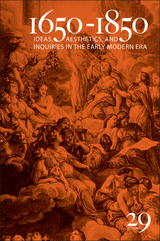 1650-1850: Ideas, Aesthetics, and Inquiries in the Early Modern Era (Volume 29)
Kevin L. Cope
Bucknell University Press, 2024 Exploratory, investigative, and energetically analytical, 1650–1850 covers the full expanse of long eighteenth-century thought, writing, and art while delivering abundant revelatory detail. Essays on well-known cultural figures combine with studies of emerging topics to unveil a vivid rendering of a dynamic period, simultaneously committed to singular genius and universal improvement. Welcoming research on all nations and language traditions, 1650–1850 invites readers into a truly global Enlightenment. Topics in volume 29 include Samuel Johnson’s notions about the education of women and a refreshing account of Sir Joseph Banks’s globetrotting. A guest-edited, illustration-rich, interdisciplinary special feature explores the cultural implications of water. As always, 1650–1850 culminates in a bevy of full-length book reviews critiquing the latest scholarship on long-established specialties, unusual subjects, and broad reevaluations of the period.
ISSN 1065-3112
Published by Bucknell University Press, distributed worldwide by Rutgers University Press.
 1650-1850: Ideas, Aesthetics, and Inquiries in the Early Modern Era (Volume 30)
Kevin L. Cope
Bucknell University Press, 2025 Exploratory, investigative, and energetically analytical, 1650–1850 covers the full expanse of long-eighteenth-century thought, writing, and art while delivering abundant revelatory detail. Essays on well-known cultural figures combine with studies of emerging topics to unveil a vivid rendering of a dynamic period, simultaneously committed to singular genius and universal improvement.
The contributors to volume 30 join with Enlightenment thinkers in pulling, pushing, and stretching the elastic boundaries of human experience. Essays on comical apocalypticism, the evolution of satire, and the Asian periphery of English literature open a volume that offers two special features on extreme aspects of a modernizing world. The first probes the undiscovered world of last wills and testaments, while the second explores the soaring world of eighteenth-century birds. As always, 1650–1850 culminates in a bevy of book reviews critiquing the latest scholarship on long-established specialties, unusual subjects, and broad reevaluations of the period.
Published by Bucknell University Press. Distributed worldwide by Rutgers University Press.
ISSN: 1065-3112
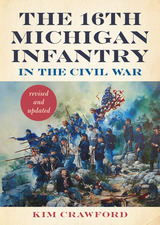 The 16th Michigan Infantry in the Civil War, Revised and Updated
Kim Crawford
Michigan State University Press, 2019 On the hot summer evening of July 2, 1863, at the climax of the struggle for a Pennsylvania hill called Little Round Top, four Confederate regiments charge up the western slope, attacking the smallest and most exposed of their Union foe: the 16th Michigan Infantry. Terrible fighting has raged, but what happens next will ultimately—and unfairly—stain the reputation of one of the Army of the Potomac’s veteran combat outfits, made up of men from Detroit, Saginaw, Ontonagon, Hillsdale, Lansing, Adrian, Plymouth, and Albion. In the dramatic interpretation of the struggle for Little Round Top that followed the Battle of Gettysburg, the 16th Michigan Infantry would be remembered as the one that broke during perhaps the most important turning point of the war. Their colonel, a young lawyer from Ann Arbor, would pay with his life, redeeming his own reputation, while a kind of code of silence about what happened at Little Round Top was adopted by the regiment’s survivors. From soldiers’ letters, journals, and memoirs, this book relates their experiences in camp, on the march, and in battle, including their controversial role at Gettysburg, up to the surrender of Gen. Robert E. Lee at Appomattox Court House.
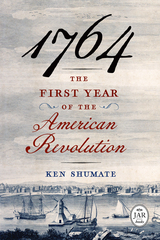 1764—The First Year of the American Revolution
Ken Shumate
Westholme Publishing, 2021 How the American Response to British Plans for Parliamentary Taxation Set in Motion the Movement for Independence
The year 1764 is of extraordinary importance to the history of the American Revolution. It was a watershed year in the relationship between Great Britain and its North American colonies.
In 1763, the British began to strictly enforce the laws of trade in order to advance a newly formulated colonial policy that included use of customs duties as a means of drawing revenue from the colonies. Americans early in 1764 protested that the laws being enforced were economically unsound and would be destructive to the trade of the colonies. Despite knowing of the American discontent, British officials moved forward with their new colonial policy. Resolutions made by the House of Commons in March 1764 not only codified a more restrictive trade policy, but revealed a plan to impose direct parliamentary taxation. A resolution to levy stamp duties brought forth a storm of American petitions and essays in late 1764 that constitute the beginning of what has become known as the Stamp Act Crisis.
In 1764: The First Year of the American Revolution, Ken Shumate presents the American arguments against the new British policy. The most prominent protests against direct parliamentary taxation were made by New York, Massachusetts, Virginia, Connecticut, and Rhode Island. Supporting the petitions were thoughtful essays by James Otis, Oxenbridge Thacher, Richard Bland, Thomas Fitch, and Stephen Hopkins. Shumate demonstrates the importance of these petitions and essays, written before the passage of the Stamp Act in 1765, as establishing the constitutional basis for the heated protests of that year and the following decade. The British interpretation of these writings as rejecting the supremacy of Parliament—even the sovereignty of Great Britain—further motivated the need for the Stamp Act as a demonstration of the fundamental right of Parliament to levy such taxes.
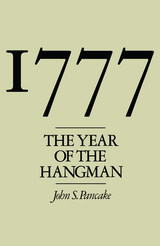 1777: The Year of the Hangman
John S. Pancake
University of Alabama Press, 1977 A detailed study of the British invasion from Canada during the War of Independence
No one who has read the history of the War of Independence can fail to be fascinated by the campaign of Gentleman Johnny Burgoyne. The story evokes pictures in the mind's eye: scarlet-coated Englishmen; the green and blue uniforms of the German mercenaries; the flash of brass and silver and steel accoutrements; the swarms of Indians in their war paint; the whole moving through the green forests or sailing the blue waters of lakes and rivers. Even the names have a lyrical tone: Richelieu, Champlain, Oriskany, Ticonderoga, and La Chine.
Part of this fascination is the fact that the fate of the expedition marked a turning point in the history of the war. It is not surprising that there has been a host of chroniclers, scholars, and novelists, and those who fall in a category somewhere between because their artistry bridges the gaps that footnoted facts cannot, and so allows some scope for imagination (and may teach more history than the rest).
This fascination was partly responsible for Pancake’s exploration of this particular part of the history of the war. There was also the fact that no scholar since Hoffman Nickerson in his Turning Point of the Revolution (1926) has attempted a detailed study of the British invasion from Canada, although there has been a vast amount of literature on specific aspects of the campaign. No study to date has attempted to link the Canadian expedition to the concurrent operation of General Sir William Howe in Pennsylvania in such a way as to present a complete story of the campaign of 1777. From the point of its inception and launching by the American Secretary, Lord George Germain, to the point where it was reduced to a shambles at the end of the year.
 1812: War with America
Jon Latimer
Harvard University Press, 2010 Listen to a short interview with Jon LatimerHost: Chris Gondek | Producer: Heron & Crane
In the first complete history of the War of 1812 written from a British perspective, Jon Latimer offers an authoritative and compelling account that places the conflict in its strategic context within the Napoleonic wars. The British viewed the War of 1812 as an ill-fated attempt by the young American republic to annex Canada. For British Canada, populated by many loyalists who had fled the American Revolution, this was a war for survival. The Americans aimed both to assert their nationhood on the global stage and to expand their territory northward and westward.
Americans would later find in this war many iconic moments in their national story--the bombardment of Fort McHenry (the inspiration for Francis Scott Key's "Star Spangled Banner"); the Battle of Lake Erie; the burning of Washington; the death of Tecumseh; Andrew Jackson's victory at New Orleans--but their war of conquest was ultimately a failure. Even the issues of neutrality and impressment that had triggered the war were not resolved in the peace treaty. For Britain, the war was subsumed under a long conflict to stop Napoleon and to preserve the empire. The one lasting result of the war was in Canada, where the British victory eliminated the threat of American conquest, and set Canadians on the road toward confederation.
Latimer describes events not merely through the eyes of generals, admirals, and politicians but through those of the soldiers, sailors, and ordinary people who were directly affected. Drawing on personal letters, diaries, and memoirs, he crafts an intimate narrative that marches the reader into the heat of battle.
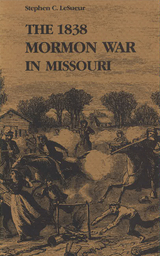 The 1838 Mormon War in Missouri
Stephen C. LeSueur
University of Missouri Press, 1990 In the summer and fall of 1838, animosity between Mormons and their neighbors in western Missouri erupted into an armed conflict known as the Mormon War. The conflict continued until early November, when the outnumbered Mormons surrendered and agreed to leave the state. In this major new interpretation of those events, LeSueur argues that while a number of prejudices and fears stimulated the opposition of Missourians to their Mormon neighbors, Mormon militancy contributed greatly to the animosity between them. Prejudice and poor judgment characterized leaders on both sides of the struggle. In addition, LeSueur views the conflict as an expression of attitudes and beliefs that have fostered a vigilante tradition in the United States. The willingness of both Missourians and Mormons to adopt extralegal measures to protect and enforce community values led to the breakdown of civil control and to open warfare in northwestern Missouri.
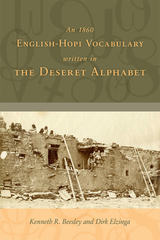 An 1860 English-Hopi Vocabulary Written in the Deseret Alphabet
Kenneth R. Beesley
University of Utah Press, 2014 In 1859 Brigham Young sent two Mormon missionaries to live among the Hopi, “reduce their dialect to a written language,” and then teach it to the Hopi so that they would be able to read the Book of Mormon in their own tongue. Young instructed the men to teach the Hopi to write in the Deseret Alphabet, a phonemic system that he was promoting in place of the traditional Latin alphabet. While the Deseret Alphabet faded out of use in just over twenty years, the manuscript penned in Deseret by one of the missionaries has remained in existence. For decades it sat unidentified in the Archives of the Church of Jesus Christ of the Latter-day Saints in Salt Lake Citya mystery document having no title, author, or date. But authors Beesley and Elzinga have now traced the manuscript’s origin to the missionaries of 1859-60 and decoded its Hopi-English vocabulary written in the short-lived Deseret Alphabet. The resulting book offers a fascinating mix of linguistics, Mormon history, and Native American studies.
The volume reproduces all 486 vocabulary entries of the original manuscript, presenting the Deseret and the modern English and Hopi translations. It explains the history of the Deseret Alphabet as well as that of the Mormon missions to the Hopi, while fleshing out the background of the two missionaries, Marion Jackson Shelton, who wrote the manuscript, and his companion, Thales Hastings Haskell. The book will be of interest to linguists, historians, ethnographers, and others who are curious about the unique combination of topics this work connects.
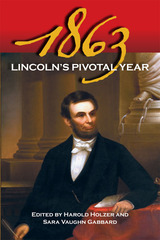 1863: Lincoln's Pivotal Year
Edited by Harold Holzer and Sara Vaughn Gabbard
Southern Illinois University Press, 2013 Only hours into the new year of 1863, Abraham Lincoln performed perhaps his most famous action as president by signing the Emancipation Proclamation. Rather than remaining the highlight of the coming months, however, this monumental act marked only the beginning of the most pivotal year of Lincoln’s presidency and the most revolutionary twelve months of the entire Civil War. In recognition of the sesquicentennial of this tumultuous time, prominent Civil War scholars explore the events and personalities that dominated 1863 in this enlightening volume, providing a unique historical perspective on a critical period in American history. Several defining moments of Lincoln’s presidency took place in 1863, including the most titanic battle ever to shake the American continent, which soon inspired the most famous presidential speech in American history. The ten essays in this book explore the year’s important events and developments, including the response to the signing of the Emancipation Proclamation; the battles of Gettysburg and Vicksburg, and other less-well-known confrontations; the New York City draft riots; several constitutional issues involving the war powers of President Lincoln; and the Gettysburg Address and its continued impact on American thought. Other topics include the adaptation of photography for war coverage; the critical use of images; the military role of the navy; and Lincoln’s family life during this fiery trial. With an informative introduction by noted Lincoln scholar Harold Holzer and a chronology that places the high-profile events of 1863 in context with cultural and domestic policy advances of the day, this remarkable compendium opens a window into a year that proved decisive not only for the Civil War and Lincoln’s presidency but also for the entire course of American history.
 1865 Alabama: From Civil War to Uncivil Peace
Christopher Lyle McIlwain Sr.
University of Alabama Press, 2017 The epic final year of the Civil War in Alabama and its effects on Alabama politics today
To understand Alabama today, it's necessary to understand what happened in 1865. In 1865 Alabama: From Civil War to Uncivil Peace Christopher McIlwain examines the end of the Civil War and the early days of Reconstruction, tracing how the action—and inaction—of leaders in the state during those twelve months shaped the decades that followed as well as state politics today. McIlwain focuses on four factors: the immediate and unconditional emancipation of enslaved people, the destruction of Alabama’s industrial economy, significant broadening of northern support for suffrage rights for freedmen, and a long scarcity of investment capital. Each element proves important to understanding aspects of Alabama today.
Relevant events outside Alabama are woven into the narrative, including McIlwain’s controversial argument regarding the effect of Lincoln’s assassination. Most historians assume that Lincoln favored black suffrage and that he would have led the fight to impose that on the South. But he made it clear to his cabinet members that granting suffrage rights was a matter to be decided by the southern states, not the federal government. Thus, according to McIlwain, if Lincoln had lived, black suffrage would not have been the issue it became in Alabama.
In his fresh analysis of what really happened in Alabama in 1865 and why—McIlwain illuminates that Alabama's challenges were neither entirely the fault of northern or southern policies but rather the complex interaction between the two.
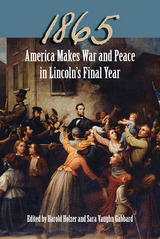 1865: America Makes War and Peace in Lincoln’s Final Year
Edited by Harold Holzer and Sara Vaughn Gabbard
Southern Illinois University Press, 2015 In 1865 Americans faced some of the most important issues in the nation’s history: the final battles of the Civil War, the struggle to pass the Thirteenth Amendment, the peace process, reconstruction, the role of freed slaves, the tragedy of Abraham Lincoln's assassination, and the trials of the conspirators. In this illuminating collection, prominent historians of nineteenth-century America offer insightful overviews of the individuals, events, and issues on 1865 that shaped the future of the United States. Following an introduction by renowned Lincoln scholar Harold Holzer, nine new essays explore the end of the Civil War, Lincoln’s death, and the start of the tentative peace in 1865. Michael Vorenberg discusses how Lincoln shepherded through the House of Representatives the resolution sending the Thirteenth Amendment to the states for ratification, John F. Marszalek and Michael B. Ballard examine the partnership of Lincoln’s war management and General Ulysses S. Grant’s crucial last thrusts against Robert E. Lee, and Richard Striner recounts how Lincoln faced down Confederate emissaries who proposed immediate armistice if Lincoln were to reverse the Emancipation Proclamation. Ronald C. White Jr. offers a fresh look at Lincoln’s second inaugural address, and Richard Wightman Fox provides a vivid narrative of Lincoln’s dramatic walk through Richmond after the Confederates abandoned their capital. Turning to Lincoln’s assassination, Edward Steers Jr. relates the story of Booth’s organizational efforts that resulted in the events of that fateful day, and Frank J. Williams explains the conspirators’ trial and whether they should have faced military or civilian tribunals. Addressing the issue of black suffrage, Edna Greene Medford focuses on the African American experience in the final year of the war. Finally, Holzer examines the use of visual arts to preserve the life and legacy of the martyred president. Rounding out the volume are a chronology of national and international events during 1865, a close look at Lincoln’s activities and writings from January 1 through April 14, and other pertinent materials. This thoughtful collection provides an engaging evaluation of one of the most crucial years in America’s evolution.
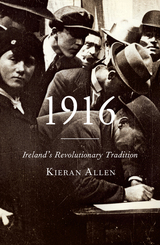 1916: Ireland's Revolutionary Tradition
Kieran Allen
Pluto Press, 2016 The Easter Rising of 1916, in which just over a thousand Irish rebels seized key locations in Dublin and proclaimed the independence of the Irish Republic before being brutally suppressed by the vastly larger and better-equipped British Army, is an event whose meaning remains contested to this day. For some it represents a blood sacrifice without the hope—or even the intention—of success. For others, it was the first act in a tumultuous political drama played out in Dublin streets and London cabinet rooms that led to the eventual formation of an independent Irish state.
In 1916, Kieran Allen argues that this pivotal moment in Irish history has been obscured by those who see it only as a prelude for a war of independence. Emphasizing an often ignored social and political radicalism at the heart of the rebellion, he shows that it gave birth to a revolutionary tradition that continues to haunt the Irish elite. Socialist aspirations mixed, and sometimes clashed, with the republican current, but both were crushed in a counterrevolution that accompanied the Anglo-Irish treaty of 1921. The result today is a partitioned Ireland that acts as a neoliberal tax haven for multinational corporations—a state of affairs quite alien to both Connolly’s and Pearse’s vision.
Published to coincide with the Rising’s centennial, 1916: Ireland’s Revolutionary Tradition re-establishes the political role of socialist republican figures, offers a highly accessible history of the Easter Rising, and explores the militancy and radicalism that continues to haunt the Irish elite one hundred years later.
 The 1922 General Election Reconsidered: High Politics and the Birth of the Modern British Election
G.H. Bennett
University of London Press, 2025 Revisiting the high-stakes politics of 1922, G.H. Bennett unveils how one election transformed Britain’s electoral system and redefined party alliances for decades to come.
The 1922 General Election was more than just another political contest; it was the turning point that shaped the modern British electoral landscape. In The 1922 General Election Reconsidered, G.H. Bennett revisits this pivotal moment with fresh insight, drawing on newly available archival materials and digitized resources to decipher the high-stakes maneuvering and backroom negotiations that defined the campaign. Covering the dramatic collapse of the Lloyd George coalition and the intricate web of party alliances and local political machinations, this book captures the election in unprecedented detail.
Bennett studies the key players and the seismic shifts that emerged in the wake of the vote. He also looks into how informal cooperation between parties blurred political lines and how media speculation shaped public perceptions. By placing the election in both its immediate and long-term context, The 1922 General Election Reconsidered is a compelling reconsideration of an often-overlooked moment in British political history that continues to influence elections a century later.
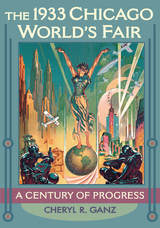 The 1933 Chicago World's Fair: A Century of Progress
Cheryl R. Ganz
University of Illinois Press, 2012 Chicago's 1933 world's fair set a new direction for international expositions. Earlier fairs had exhibited technological advances, but Chicago's fair organizers used the very idea of progress to buoy national optimism during the Depression's darkest years. Orchestrated by business leaders and engineers, almost all former military men, the fair reflected a business-military-engineering model that envisioned a promising future through science and technology's application to everyday life. Fair organizers, together with corporate leaders, believed that progress rides on the tide of technological innovation and consumerism. But not all those who struggled for a voice at Chicago's 1933 exposition had abandoned the traditional notions of progress that entailed social justice and equality, recognition of ethnic and gender-related accomplishments, and personal freedom and expression. The stark pronouncement of the fair's motto, "Science Finds, Industry Applies, Man Conforms," was challenged by iconoclasts such as Sally Rand, whose provocative fan dance became a persistent symbol of the fair, as well as a handful of others, including African Americans, ethnic populations and foreign nationals, groups of working women, and even well-heeled socialites. They all met obstacles but ultimately introduced personal, social definitions of "progress" and thereby influenced the ways the fair took shape. In this engaging social and cultural history, Cheryl R. Ganz examines Chicago's second world's fair through the lenses of technology, ethnicity, and gender. The book also features eighty-six photographs--nearly half of which are full color--of key locations, exhibits, and people, as well as authentic ticket stubs, postcards, pamphlets, posters, and other items. From fan dancers to fan belts, The 1933 Chicago World's Fair: A Century of Progress offers the compelling, untold stories of fair planners and participants who showcased education, industry, and entertainment to sell optimism during the depths of the Great Depression.
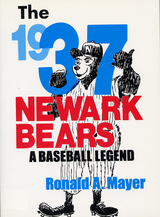 The 1937 Newark Bears: A Baseball Legend
Mayer, Ronald A
Rutgers University Press, 1994 Here is the fascinating account, rich in nostalgia, of the greatest minor league team in the history of baseball. Ronald Mayer recounts the wonderful early years of the Newark Bears when millionaire beer baron Jacob Ruppert, owner of the New York Yankees, purchased the team from the newspaper publisher Paul Block in 1931. Mayer traces the Bears' exciting first five seasons under Ruppert and the building of a farm system that eventually produced the great Yankee dynasty. These colorful early seasons were sprinkled with some of the great names of the American pastime: Ed Barrow, Paul Kritchell, Al Mamaux, Red Rolfe, Babe Ruth, Shag Shaughnessey, Bob Shawkey, and George Weiss.
The Bears' finest hour, however, came in 1937 with a team that many experts consider the greatest in the history of the minor leagues. This book captures all the thrilling moments of that memorable season--action-packed Spring training at Sebring, Florida, the day-to-day excitement of the pennant race, the vivid play-by-play action of the semifinal playoff against the Syracuse Chiefs, the final playoof against the Baltimore Orioles, and finally, the spellbinding, unforgettable Little World Series against the powerful Columbus Red Birds.
This book is packed with photos and colorful profiles of Babe Dahlgren, Atley Donald, Joe Gordon, Charley Keller, George McQuinn, manager Oscar Vitt, and the rest of the great Newark players. It's all here, in the most comprehensive and thoroughly researched book every published about the Newark Bears.
The 1956 Hungarian Revolution: A History in Documents
The National Security Archive Békés
Central European University Press, 2003 If there had been all-news television channels in 1956, viewers around the world would have been glued to their sets between October 23 and November 4. This book tells the story of the Hungarian Revolution in 120 original documents, ranging from the minutes of the first meeting of Khrushchev with Hungarian bosses after Stalin's death in 1953 to Yeltsin's declaration made in 1992. Other documents include letters from Yuri Andropov, Soviet Ambassador in Budapest during and after the revolt. The great majority of the material appears in English for the first time, and almost all come from archives that were inaccessible until the 1990s.
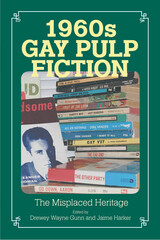 1960s Gay Pulp Fiction: The Misplaced Heritage
Drewey Wayne Gunn
University of Massachusetts Press, 2013 As a result of a series of court cases, by the mid-1960s the U.S. post office could no longer interdict books that contained homosexuality. Gay writers were eager to take advantage of this new freedom, but the only houses poised to capitalize on the outpouring of manuscripts were "adult" paperback publishers who marketed their products with salacious covers. Gay critics, unlike their lesbian counterparts, have for the most part declined to take these works seriously, even though they cover an enormous range of genres: adventures, blue-collar and gray-flannel novels, coming-out stories, detective fiction, gothic novels, historical romances, military stories, political novels, prison fiction, romances, satires, sports stories, and spy thrillers—with far more short story collections than is generally realized. Twelve scholars have now banded together to begin a recovery of this largely forgotten explosion of gay writing that occurred in the 1960s.
Descriptions of these pulps have often been inadequate and misinforming, the result of misleading covers, unrepresentative sampling of texts, and a political blindness that refuses to grant worth to pre-Stonewall writing. This volume charts the broader implications of this state of affairs before examining some of the more significant pulp writers from the period. It brings together a diverse range of scholars, methodologies, and reading strategies. The evidence that these essays amass clearly demonstrates the significance of gay pulps for gay literary history, queer cultural studies, and book history.
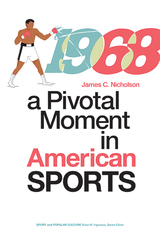 1968: A Pivotal Moment in American Sports
James C. Nicholson
University of Tennessee Press, 2019 Amid anti-Vietnam war protests, political assassinations, and urban unrest, the United States had descended into an era of domestic turmoil by the summer of 1968. Americans were split along nearly every imaginable line, and discord penetrated all facets of American culture. As James Nicholson proves in this thought-provoking volume, the sports arena was no exception.
Opening with Vince Lombardi’s last win as coach of the Packers in Super Bowl II and closing with Jo Namath’s Super Bowl III guarantee, 1968 charts a course through the turbulent waters of American sports over a single improbable year. Nicholson chronicles and scrutinizes a number of events that reflected-and fed-the acrimony of that year: the Masters golf tournament, in which enforcement of an arcane rule cost a foreign player a chance at victory; the disqualification of the Kentucky Derby winner for doping; Muhammed Ali’s appeal of a criminal conviction for draft evasion; an unorthodox rendition of the national anthem at the World Series that nearly overshadowed the game it preceded; and a silent gesture of protest at the Mexico City Olympics that shocked the nation and world.
While 1968 was not the first year that sports converged with social and political strife in America, echoes of the past in today’s culture wars bring a heightened relevance to the events of a half century ago. In reading Nicholson’s work, scholars and sports fans alike will receive an instructive glimpse into the nature of persistent division in the United States as it reflected in our national pastimes.
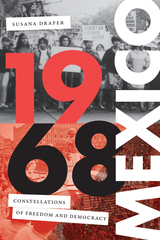 1968 Mexico: Constellations of Freedom and Democracy
Susana Draper
Duke University Press, 2018 Recognizing the fiftieth anniversary of the protests, strikes, and violent struggles that formed the political and cultural backdrop of 1968 across Europe, the United States, and Latin America, Susana Draper offers a nuanced perspective of the 1968 movement in Mexico. She challenges the dominant cultural narrative of the movement that has emphasized the importance of the October 2nd Tlatelolco Massacre and the responses of male student leaders. From marginal cinema collectives to women’s cooperative experiments, Draper reveals new archives of revolutionary participation that provide insight into how 1968 and its many afterlives are understood in Mexico and beyond. By giving voice to Mexican Marxist philosophers, political prisoners, and women who participated in the movement, Draper counters the canonical memorialization of 1968 by illustrating how many diverse voices inspired alternative forms of political participation. Given the current rise of social movements around the globe, in 1968 Mexico Draper provides a new framework to understand the events of 1968 in order to rethink the everyday existential, political, and philosophical problems of the present.
 1970: The Last Days
Sonallah Ibrahim
Seagull Books, 2024 A riveting novel that is both an indictment and an elegy, a second-person memoir of Nasser’s final months in the voice of his former prisoner.
In 1959, at the age of twenty-two, Egyptian novelist Sonallah Ibrahim was imprisoned by Gamal Abdel Nasser’s regime. Over the following five years in prison in Egypt’s Western Desert, Ibrahim kept diaries that he smuggled out on cigarette papers.
In this novel, Ibrahim takes up Nasser as a fictional character tied tightly to real events, offering a window into his daily life in his final years. Ibrahim follows Nasser during the War of Attrition and the aftermath of the 1967 war with Israel and looks back on the events of the previous decades. He also chronicles Nasser at his most vulnerable, detailing a more private set of Nasser’s setbacks and defeats: the daily routines of a diabetic suffering from heart trouble in the months before his death. Political events as well as social and economic transformations are narrated through newspaper clippings and archival fragments, painting a portrait of the decline of a man who was once larger than life.
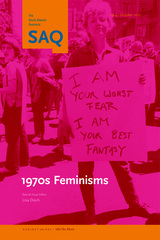 1970s Feminisms
Lisa J. Disch, special issue editor
Duke University Press For more than a decade, feminist historians and historiographers have engaged in challenging the “third wave” portrait of 1970s feminism as essentialist, white, middle-class, uninterested in racism, and theoretically naive. This task has involved setting the record straight about women’s liberation by interrogating how that image took hold in the public imagination and among academic feminists. This issue invites feminist theorists to return to women’s liberation—to the texts, genres, and cultural productions to which the movement gave rise—for a more nuanced look at its conceptual and political consequences. The essays in this issue explore such topics as the ambivalent legacies of women’s liberation; the production of feminist subjectivity in mass culture and abortion documentaries; the political effects of archiving Chicana feminism; and conceptual and generic innovations in the work of Gayle Rubin, Christine Delphy, and Shulamith Firestone.
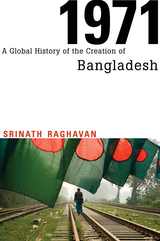 1971: A Global History of the Creation of Bangladesh
Srinath Raghavan
Harvard University Press, 2013 The war of 1971 was the most significant geopolitical event in the Indian subcontinent since its partition in 1947. At one swoop, it led to the creation of Bangladesh, and it tilted the balance of power between India and Pakistan steeply in favor of India. The Line of Control in Kashmir, the nuclearization of India and Pakistan, the conflicts in Siachen Glacier and Kargil, the insurgency in Kashmir, the political travails of Bangladesh—all can be traced back to the intense nine months in 1971.
Against the grain of received wisdom, Srinath Raghavan contends that far from being a predestined event, the creation of Bangladesh was the product of conjuncture and contingency, choice and chance. The breakup of Pakistan and the emergence of Bangladesh can be understood only in a wider international context of the period: decolonization, the Cold War, and incipient globalization. In a narrative populated by the likes of Nixon, Kissinger, Zhou Enlai, Indira Gandhi, Zulfikar Ali Bhutto, Sheikh Mujibur Rahman, Tariq Ali, George Harrison, Ravi Shankar, and Bob Dylan, Raghavan vividly portrays the stellar international cast that shaped the origins and outcome of the Bangladesh crisis.
This strikingly original history uses the example of 1971 to open a window to the nature of international humanitarian crises, their management, and their unintended outcomes.
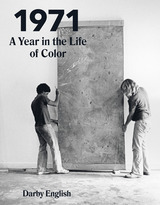 1971: A Year in the Life of Color
Darby English
University of Chicago Press, 2016 In this book, art historian Darby English explores the year 1971, when two exhibitions opened that brought modernist painting and sculpture into the burning heart of United States cultural politics: Contemporary Black Artists in America, at the Whitney Museum of American Art, and The DeLuxe Show, a racially integrated abstract art exhibition presented in a renovated movie theater in a Houston ghetto.
1971: A Year in the Life of Color looks at many black artists’ desire to gain freedom from overt racial representation, as well as their efforts—and those of their advocates—to further that aim through public exhibition. Amid calls to define a “black aesthetic,” these experiments with modernist art prioritized cultural interaction and instability. Contemporary Black Artists in America highlighted abstraction as a stance against normative approaches, while The DeLuxe Show positioned abstraction in a center of urban blight. The importance of these experiments, English argues, came partly from color’s special status as a cultural symbol and partly from investigations of color already under way in late modern art and criticism. With their supporters, black modernists—among them Peter Bradley, Frederick Eversley, Alvin Loving, Raymond Saunders, and Alma Thomas—rose above the demand to represent or be represented, compromising nothing in their appeals for interracial collaboration and, above all, responding with optimism rather than cynicism to the surrounding culture’s preoccupation with color.
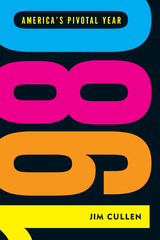 1980: America's Pivotal Year
Jim Cullen
Rutgers University Press, 2023 1980 was a turning point in American history. When the year began, it was still very much the 1970s, with Jimmy Carter in the White House, a sluggish economy marked by high inflation, and the disco still riding the airwaves. When it ended, Ronald Reagan won the presidency in a landslide, inaugurating a rightward turn in American politics and culture. We still feel the effects of this tectonic shift today, as even subsequent Democratic administrations have offered neoliberal economic and social policies that owe more to Reagan than to FDR or LBJ. To understand what the American public was thinking during this pivotal year, we need to examine what they were reading, listening to, and watching.
1980: America's Pivotal Year puts the news events of the era—everything from the Iran hostage crisis to the rise of televangelism—into conversation with the year’s popular culture. Separate chapters focus on the movies, television shows, songs, and books that Americans were talking about that year, including both the biggest hits and some notable flops that failed to capture the shifting zeitgeist. As he looks at the events that had Americans glued to their screens, from the Miracle on Ice to the mystery of Who Shot J.R., cultural historian Jim Cullen garners surprising insights about how Americans’ attitudes were changing as they entered the 1980s. Praise for Jim Cullen's previous Rutgers University Press books: "Informed and perceptive" —Norman Lear on Those Were the Days: Why All in the Family Still Matters
"Jim Cullen is one of the most acute cultural historians writing today." —Louis P. Masur, author of The Sum of Our Dreams on Martin Scorsese and the American Dream
"This is a terrific book, fun and learned and provocative....Cullen provides an entertaining and thoughtful account of the ways that we remember and how this is influenced and directed by what we watch." —Jerome de Groot, author of Consuming History on From Memory to History
 1989: Revolutionary Ideas and Ideals
Krishan Kumar
University of Minnesota Press, 2001 In 1989, from East Berlin to Budapest and Bucharest to Moscow, communism was falling. The walls were coming down and the world was being changed in ways that seemed entirely new. The conflict of ideas and ideals that began with the French Revolution of 1789 culminated in these revolutions, which raised the prospects of the "return to Europe" of East and Central European nations, the "restarting of their history," even, for some, the "end of history." What such assertions and aspirations meant, and what the larger events that inspired them mean-not just for the world of history and politics, but for our very understanding of that world-are the questions Krishan Kumar explores in 1989. A well-known and widely respected scholar, Kumar places these revolutions of 1989 in the broadest framework of political and social thought, helping us see how certain ideas, traditions, and ideological developments influenced or accompanied these movements-and how they might continue to play out. Asking questions about some of the central dilemmas facing modern society in the new century, Kumar offers critical insight into how these questions might be answered and how political, social, and historical ideas and ideals can shape our destiny. Contradictions Series, volume 12
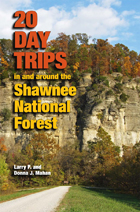 20 Day Trips in and around the Shawnee National Forest
Larry P. and Donna J. Mahan
Southern Illinois University Press, 2013 One of the unique and most scenic treasures in the Midwest, the Shawnee National Forest spans more than 279,000 acres deep in southern Illinois. The natural beauty, stunning vistas, and diverse flora and fauna of this picturesque region invite exploration by all who love nature. This easy-to-use guidebook highlights 20 exciting day or weekend trips within and near the Shawnee National Forest, making it easy to take advantage of the forest’s myriad opportunities for outdoor recreational activity. Intended for those without extensive hiking or camping experience, the guide provides all of the information necessary to safely and proficiently explore all the forest has to offer. Entertaining narratives describe each journey in vivid detail, offering advice on needed supplies, pointing out shortcuts, and spotlighting not-to-miss views. Entries also include thorough directions, GPS coordinates, trail difficulty ratings, landform descriptions, exact distances between points, and a list of available facilities at each location. From biking and bird watching to hiking, horseback riding, and rock climbing, the Shawnee National Forest is home to an abundance of possibilities for outdoor fun. With this practical guide in hand, adventure seekers and nature lovers alike can make the most of southern Illinois’s own natural treasure.
Best Travel Guide of the Year by Booklist, 2013
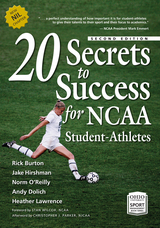 20 Secrets to Success for NCAA Student-Athletes
Rick Burton
Ohio University Press, 2021 The premier NCAA student-athlete handbook, now in a second, updated edition designed for today’s competitive market and with a new chapter on name, image, and likeness (NIL) rights. Few student-athletes dreaming of athletic stardom ever make it to the pros. Yet, the discipline and skills they’ve developed while balancing a sport and academics make them ideally suited for satisfying careers elsewhere. The book’s authors draw on personal experience, interviews, expert opinion, and industry data to provide a game plan for student-athletes to help them transition from high school to college, navigate evolving rules about NIL rights, and find success in life after college. Modeled after Stephen Covey’s The 7 Habits of Highly Effective People, this expanded and updated guide provides a much-needed strategy for student-athletes as they prepare for postcollege careers, while serving as a valuable resource for their parents, coaches, and sports administrators across the country.
20 Secrets to Success for NCAA Student-Athletes Who Won’t Go Pro
Rick Burton
Ohio University Press, 2017 The vast majority of student-athletes dreaming of athletic stardom won’t make it to the pros. Yet, the discipline and skills they’ve developed while balancing a sport and academics make them ideally suited for satisfying careers elsewhere. In 20 Secrets to Success for NCAA Student-Athletes Who Won’t Go Pro, the authors draw on personal experience, interviews, expert opinion, and industry data to provide a game plan for student-athletes through key transitions at each stage of their careers, from high school through college and beyond. Modeled on Stephen Covey’s The 7 Habits of Highly Effective People, this book provides a much-needed strategy for achieving career success. Readable and concise, it will be a valuable tool for students, parents, and sports administrators.
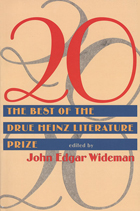 20: Twenty Best Of Drue Heinz Literature Prize
John Edgar Wideman
University of Pittsburgh Press, 2003 The Drue Heinz Literature Prize was established in 1980 to encourage and support the writing and reading of short fiction. Over the past twenty years judges such as Robert Penn Warren, Raymond Carver, Joyce Carol Oates, Margaret Atwood, Russell Banks, Alice McDermott, and Frank Conroy have selected the best collections from the hundreds submitted annually by up-and-coming writers.
20 represents the best of the best—one story from each of the prize-winning volumes. Chosen by acclaimed author John Edgar Wideman, the selections cover a broad range of inventive and original characters, settings, and emotions, charting the evolution of the short story over the past two decades. One of the most prestigious awards of its kind, the Drue Heinz Literature Prize has helped launch the careers of a score of previously "undiscovered" writers, many of whom have gone on to great critical success.
Past Winners of the Drue Heinz Literature Prize: David Bosworth, Robley Wilson, Jonathan Penner, Randall Silvis, W. D. Wetherell, Rick DeMarinis, Ellen Hunnicutt, Reginald McKnight, Maya Sonenberg, Rick Hillis, Elizabeth Graver, Jane McCafferty, Stewart O’Nan, Jennifer Cornell, Geoffrey Becker, Edith Pearlman, Katherine Vaz, Barbara Croft, Lucy Honig, Adria Bernardi.
2000 Blacks: Poems
Ajibola Tolase
University of Pittsburgh Press, 2024 2000 Blacks probes the complexity of economic and politically motivated migration from Africa, which has been referred to as “African Brain Drain.” In the first sequence of poems, Ajibola Tolase explores Africa’s history and encounters with the Western world, providing poetic insight into the economic instability precipitated by the transatlantic slave trade and exploitation of mineral resources. Moving inward, the second sequence plumbs the poet’s complex relationship with his father, connecting his emotional and then physical absence with the consequences of community disintegration.
 2001 and Counting: Kubrick, Nietzsche, and Anthropology
Bruce Kapferer
Prickly Paradigm Press, 2014 Stanley Kubrick’s 2001: A Space Odyssey is widely recognized as a cult classic. Despite mixed critical reception, the dark and difficult movie mesmerized audiences at the time of its initial screening in 1968 and went on to become one the highest grossing films of the decade.
In 2001 and Counting, renowned anthropologist Bruce Kapferer revisits 2001: A Space Odyssey, making a compelling case for its continued cultural relevance. While the film’s earliest audiences considered it to be a critical examination of European and American realities at the height of the Cold War, Kapferer shows that Kubrick’s masterwork speaks equally well to concerns of the contemporary world, including the Iraq War, the 2008 financial crisis, and the material and political effects of neoliberalism. Kapferer explores Kubrick’s central theme—the ever-changing relationship between humanity and technology—both with regard to current events and through the lens of Nietzsche’s Thus Spoke Zarathustra and the mythical concept of the eternal return.
A thought-provoking exploration of the cultural power of cinema, this volume by one of anthropology’s most insightful and imaginative thinkers will appeal to anthropologists and cineastes alike.
 2008: a Novel
Susan McCarty
Carnegie Mellon University Press, 2026 Disillusioned former high school sweethearts must come to terms with their past and present in the face of a tragedy.
It’s 2008: the age of the blog, the dawn of social media, and the birth of the smartphone. Obama is running for president on a slogan of hope, while in the shadows, an opioid crisis emerges, and the housing market teeters. Stevie and Sam, two old high school flames who have grown up and grown apart, are brought back together in the aftermath of a tragedy that throws them off the tracks of their lives. Sam, a struggling realtor, is determined to solve a mystery at any cost. Stevie hits on a plan for a “redo” that involves abandoning her adult life to relive her teenage glory days. As both struggle inside the mediocrity of their early adulthoods, the disenchanted world begins to reveal itself, and secrets threaten to overwhelm them. On the cusp of a new era of uncertainty, these old friends must find ways to reconcile their past and find their way home.
The 2008 Battle of Sadr City: Reimagining Urban Combat
David E. Johnson
RAND Corporation, 2013 In 2008, U.S. and Iraqi forces defeated an uprising in Sadr City, a district of Baghdad with ~2.4 million residents. Coalition forces’ success in this battle helped consolidate the Government of Iraq’s authority, contributing significantly to the attainment of contemporary U.S. operational objectives in Iraq. U.S. forces’ conduct of the battle illustrates a new paradigm for urban combat and indicates capabilities the Army will need in the future.
2008+ Solved Problems in Electromagnetics
Syed A. Nasar
The Institution of Engineering and Technology, 2008 This extremely valuable learning resource is for students of electromagnetics and those who wish to refresh and solidify their understanding of its challenging applications. Problem-solving drills help develop confidence, but few textbooks offer the answers, never mind the complete solutions to their chapter exercises. In this text, noted author Professor Syed Nasar has divided the book's problems into topic areas similar to a textbook and presented a wide array of problems, followed immediately by their solutions.
2011 Supplement to The American Indian Law Deskbook
CWAG Conference of Western Attorneys General
University Press of Colorado, 2011 Thorough, scholarly, and balanced, The American Indian Law Deskbook, Fourth Edition, published in February 2009, is an invaluable reference for a wide range of people working with Indian tribes, including attorneys, legal scholars, government officials, social workers, state and tribal jurists, and historians.
The 2011 Supplement reviews cases issued, as well as statutes and administrative rules adopted, from July 2010 through June 2011. It additionally covers law review articles published between spring 2010 and spring 2011.
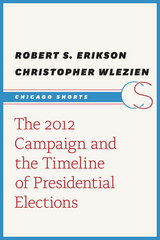 The 2012 Campaign and the Timeline of Presidential Elections
Robert S. Erikson and Christopher Wlezien
University of Chicago Press, 2014 Do voters cast ballots for the candidates whose positions best match their own? Or does the race for president come down to who runs the most effective campaign? In their book, The Timeline of Presidential Elections, published in 2012, Erikson and Wlezien documented how both factors come into play. Having amassed data from national polls covering presidential elections from 1952 to 2008, they could track how outcomes take shape over the course of an election year. But they wanted to know whether Barak Obama’s historic 2012 campaign would follow the same pattern. This e-book both presents the central arguments from Timeline and updates the statistical analysis to include data from 2012. The authors also use the 2012 presidential campaign as a test of the empirical patterns they found in the previous fifteen elections. They show that Obama’s campaign conforms to their projections, and they confirm that it is through campaigns that voters are made aware of--or not made aware of--fundamental factors like candidates’ policy positions that determine which ticket will get their votes. In other words, fundamentals matter, but only because of campaigns. The 2012 Campaign and the Timeline of Presidential Elections will be useful in courses on the election process.
 20th-Century Italian Women Writers: The Feminine Experience
Alba Amoia
Southern Illinois University Press, 1996
As an international scholar and resident of Italy who has observed and shared the experiences of Italian women for the past twenty years, Alba Amoia has positioned herself perfectly to report to English-speaking audiences the great range and variety of writing produced by twentieth-century Italian women. Her personal contact with many of the authors she discusses lends further immediacy to her study.
Rather than focusing exclusively on contemporary living authors, Amoia discusses writers from the early part of the twentieth century as well, linking them with later writers spanning twentieth-century Italy’s literary movements and political, social, and economic developments. Yet the connections and contradictions that bind and divide these women are only beginning to be established because Italy is still a splintered country in which perceptions of Italian women as a historical group have only begun to crystallize. While feminine voices resound on the Italian literary scene, only recently has feminine authority made itself felt in the professional and institutional worlds.
The eleven writers in this volume criticize the female role in Italian society, externalize women’s unconscious needs, and offer unusual examples of feminine creativity. Amoia provides a critical treatment of each author, incorporating the accepted opinion of Italian and other critics. She isolates recurrent and fundamental themes in each author’s literary career: linguistic repression by males, personal frustration in the realm of "householditude," and disorientation within Italy’s unbalanced institutions and hierarchies still strongly anchored in archaic structures.
Amoia begins her discussion with two illustrious predecessors of Italy’s contemporary women writers: the 1926 Nobel Prize winner Grazia Deledda and the premier literary feminist Sibilla Aleramo. Continuing in chronological order, Amoia discusses Gianna Manzini, Lalla Romano, Elsa Morante, Natalia Ginzburg, Rosetta Loy, and Dacia Maraini. Amoia concludes her exploration of Italian women writers with three journalists: Matilde Serao, Oriana Fallaci, and Camilla Cederna.
Essentially, Amoia has provided a collection of succinct and accessible monographs featuring pertinent biographical information and extensive bibliographies. She discusses each author’s most representative works, seeking to give readers both a sense of these women as writers and an understanding of their significance in the male-dominated literary scene.
21st-Century Hollywood: Movies in the Era of Transformation
Dixon, Wheeler Winston
Rutgers University Press, 2011 They are shot on high-definition digital cameras—with computer-generated effects added in postproduction—and transmitted to theaters, websites, and video-on-demand networks worldwide. They are viewed on laptop, iPod, and cell phone screens. They are movies in the 21st century—the product of digital technologies that have revolutionized media production, content distribution, and the experience of moviegoing itself. 21st-Century Hollywood introduces readers to these global transformations and describes the decisive roles that Hollywood is playing in determining the digital future for world cinema. It offers clear, concise explanations of a major paradigm shift that continues to reshape our relationship to the moving image. Filled with numerous detailed examples, the book will both educate and entertain film students and movie fans alike.
23 Woodcock in 22 Years: Reflections on Hunting, the Night Sky, and Our Place in the Universe
Jeff Wilkerson
University of Iowa Press, 2024 In 23 Woodcock in 22 Years, Jeff Wilkerson interweaves his twin passions of astrophysics and game hunting. Stories of how we understand the universe mesh with stories of time in the field, and in doing so capture the uncanny phenomenon of the passage of time: everything evolves around us while we expect our world to remain unchanged.
As Wilkerson’s thoughts soar to the stars that produced the chemical elements that form us and all the land and its creatures, simple reflections on going afield to harvest a woodcock for a special holiday meal ground him. What emerges is a love story about a bird, the land, and all of creation from atomic nuclei to the farthest reaches of the universe, and a reminder to acknowledge the gentle flow of time while cherishing the everyday existence around us.
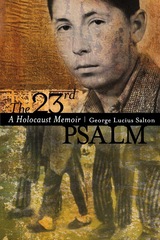 The 23rd Psalm: A Holocaust Memoir
George Lucius Salton, with Anna Salton Eisen
University of Wisconsin Press, 2004 In September, 1939, George Lucius Salton's boyhood in Tyczyn, Poland, was shattered by escalating violence and terror under German occupation. His father, a lawyer, was forbidden to work, but eleven-year-old George dug potatoes, split wood, and resourcefully helped his family. They suffered hunger and deprivation, a forced march to the Rzeszow ghetto, then eternal separation when fourteen-year-old George and his brother were left behind to labor in work camps while their parents were deported in boxcars to die in Belzec. For the next three years, George slaved and barely survived in ten concentration camps, including Rzeszow, Plaszow, Flossenburg, Colmar, Sachsenhausen, Braunschweig, Ravensbrück, and Wobbelin. Cattle cars filled with skeletal men emptied into a train yard in Colmar, France. George and the other prisoners marched under the whips and fists of SS guards. But here, unlike the taunts and rocks from villagers in Poland and Germany, there was applause. "I could clearly hear the people calling: "Shame! Shame!" . . . Suddenly, I realized that the people of Colmar were applauding us! They were condemning the inhumanity of the Germans!" Of the 500 prisoners of the Nazis who marched through the streets of Colmar in the spring of 1944, just fifty were alive one year later when the U.S. Army 82nd Airborne Division liberated the Wobbelin concentration camp on the afternoon of May 2, 1945. "I felt something stir deep within my soul. It was my true self, the one who had stayed deep within and had not forgotten how to love and how to cry, the one who had chosen life and was still standing when the last roll call ended."
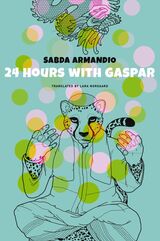 24 Hours with Gaspar
Sabda Armandio
Seagull Books, 2023 A breathtakingly imaginative futuristic crime thriller.
Decades into the future, Indonesia’s crowded capital city is underwater. A mysterious novelist searches what remains of the metropolis for the story of an old, infamous crime. He combs the streets for traces of Gaspar: private-eye-cum-criminal-mastermind who plotted a seemingly simple robbery of a jewelry store. Far from just unlocking riches, however, the heist unearths a series of interlinking conflicts that have haunted Gaspar since childhood.
In this brilliant twist of genres, this book combines noir with a laugh-out-loud detective and touches of surreal science fiction. The book’s eclectic blend of allusions and narrative strategies opens new horizons for literary crime fiction while also painting a fresh, postmodern portrait of Jakarta. In a city webbed by roadways and canals, personal vendettas trace back to political crimes and social ills. First impressions can’t be trusted, meta-literary motorbikes possess free will, and a senile witness might be a police detective’s best bet at finding the true whodunnit—if we are to believe that a single truth exists at all. It is a chess game in which your knight no longer moves in the shape of an L, and Gaspar intends to win.
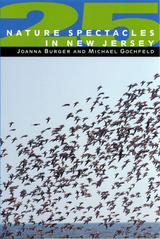 25 Nature Spectacles in New Jersey
Burger, Joanna
Rutgers University Press, 2000 Join Joanna Burger and Michael Gochfeld as they guide readers to New Jersey’s most marvelous natural spectacles. From mating horseshoe crabs in the Delaware Bay to goldenclub and orchids at Web’s Mill Bog, the authors show us Garden State nature at its best. While New Jersey boasts far more than 25 nature spectacles, the authors have selected those that are the most dramatic, predictable, and characteristic of the state so readers can easily enjoy them over and over again. Being in the right place at the right time makes all the difference, so the guidebook is organized by season to ensure the best viewing. Each chapter begins with a photo and a brief description of the spectacle. A listing of key locations, directions, and the best time to visit follows. A prime habitat section provides a brief characterization of the appropriate surroundings to look for the plant or animal spectacle. The description provides ambiance, natural and life history information allowing readers to enjoy fully what they are observing. A final section lists an agency or organization where more information can be found. The book contains maps as well as a calendar of recommended events, including the Lambertville Shad Festival and the Barnegat Bay Duck Decoy Festival. The authors also list a number of other spectacles that while they didn’t make the top 25 list, but are well-worth checking out—including a tongue-in-cheek look at what may be New Jersey’s best-known wildlife, humans at the shopping mall. This book grows from the authors’ quarter century of exploring the state’s estuaries, bays, fields, and forests, observing and enjoying its natural habitats. They’ve written the perfect guidebook for everyone, whether you are ready to head off to the great outdoors or prefer to read about nature from the comfort of your armchair.
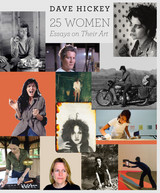 25 Women: Essays on Their Art
Dave Hickey
University of Chicago Press, 2015 Newsweek calls him “exhilarating and deeply engaging.” Time Out New York calls him “smart, provocative, and a great writer.” Critic Peter Schjeldahl, meanwhile, simply calls him “My hero.” There’s no one in the art world quite like Dave Hickey—and a new book of his writing is an event.
25 Women will not disappoint. The book collects Hickey’s best and most important writing about female artists from the past twenty years. But this is far more than a compilation: Hickey has revised each essay, bringing them up to date and drawing out common themes. Written in Hickey’s trademark style—accessible, witty, and powerfully illuminating—25 Women analyzes the work of Joan Mitchell, Bridget Riley, Fiona Rae, Lynda Benglis, Karen Carson, and many others. Hickey discusses their work as work, bringing politics and gender into the discussion only where it seems warranted by the art itself. The resulting book is not only a deep engagement with some of the most influential and innovative contemporary artists, but also a reflection on the life and role of the critic: the decisions, judgments, politics, and ethics that critics negotiate throughout their careers in the art world.
Always engaging, often controversial, and never dull, Dave Hickey is a writer who gets people excited—and talking—about art. 25 Women will thrill his many fans, and make him plenty of new ones.
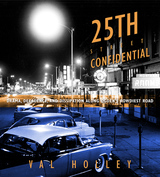 25th Street Confidential: Drama, Decadence, and Dissipation along Ogden's Rowdiest Road
Val Holley
University of Utah Press, 2013 Generations of Ogdenites have grown up absorbing 25th Street’s legends of corruption, menace, and depravity. The rest of Utah has tended to judge Ogden—known in its first century as a “gambling hell” and tenderloin, and in recent years as a degraded skid row—by the street’s gaudy reputation. Present-day Ogden embraces the afterglow of 25th Street’s decadence and successfully promotes it to tourists. In the same preservationist spirit as Denver’s Larimer Square, today’s 25th Street is home to art galleries, fine dining, live theater, street festivals, mixed-use condominiums, and the Utah State Railroad Museum.
25th Street Confidential traces Ogden’s transformation from quiet hamlet to chaotic transcontinental railroad junction as waves of non-Mormon fortune seekers swelled the city’s population. The street’s outsized role in Ogden annals illuminates larger themes in Utah and U.S. history. Most significantly, 25th Street was a crucible of Mormon-Gentile conflict, especially after the non-Mormon Liberal Party deprived its rival, the People’s Party, of long-standing control of Ogden’s municipal government in 1889. In the early twentieth-century the street was targeted in statewide Progressive Era reform efforts, and during Prohibition it would come to epitomize the futility of liquor abatement programs.
This first full-length treatment of Ogden’s rowdiest road spotlights larger-than-life figures whose careers were entwined with the street: Mayor Harman Ward Peery, who unabashedly filled the city treasury with fees and fines from vicious establishments; Belle London, the most successful madam in Utah history; and Rosetta Ducinnie Davie, the heiress to London’s legacy who became a celebrity on the street, in the courts, and in the press. Material from previously unexploited archives and more than one hundred historic photos enrich this narrative of a turbulent but unforgettable street.
Winner of the Utah Book Award in Nonfiction.
Chosen by Foreword as a finalist in the regional category for their IndieFab Book of the Year Award.
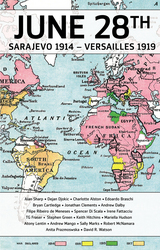 28 June: Sarajevo 1914 - Versailles 1919: The War and Peace That Made the Modern World
Edited by Alan Sharp
Haus Publishing, 2014 On June 28, 1919, the Peace Treaty was signed in the Hall of Mirrors at Versailles, five years to the day after the assassination of Archduke Franz Ferdinand in Sarajevo triggered Europe's precipitous descent into war. This war was the first conflict to be fought on a global scale. By its end in 1918, four empires had collapsed, and their minority populations, which had never before existed as independent entities, were encouraged to seek self-determination and nationhood.
Following on from Haus’s monumental thirty-two Volume series on the signatories of the Versailles peace treaty, The Makers of the Modern World, 28 June looks in greater depth at the smaller nations that are often ignored in general histories, and in doing so seeks to understand the conflict from a global perspective, asking not only how each of the signatories came to join the conflict but also giving an overview of the long-term consequences of their having done so.
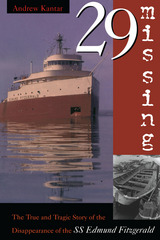 29 Missing: The True and Tragic Story of the Disappearance of the SS Edmund Fitzgerald
Andrew Kantar
Michigan State University Press, 1998 On November 10, 1975, SS Edmund Fitzgerald, a giant freighter, sank with its entire crew of 29 aboard, in one of the most violent storms ever witnessed on Lake Superior. In 29 Missing, Kantar tells the "Fitz's" story from the christening in 1958 as the largest ship on the Great Lakes to the expedition in 1995 to recover the ship's bell in what proved to be a moving memorial to the lost crew. Using information from government investigative reports, the book provides a dramatic hour-by-hour account of what transpired during that terrible voyage, including dialogue from actual radio transmissions between the Fitzgerald and the Arthur Anderson, the freighter that followed behind the Fitz.
In his passionate retelling of the story, designed primarily for young adults, Kantar provides the facts leading up to the disappearance, detailing the subsequent expeditions to the wreck site as well as the leading theories about the sinking that have been debated by maritime experts.
2nd Chance
Daniel Becker
New Issues Poetry and Prose, 2020 The poems in 2nd Chance are written in the voice of a doctor; the speaker often imagines he is talking to students, residents, patients, families—anyone who is ill or has witnessed illness and suffering. The poet, Daniel M. Becker, has been a physician for over thirty years, working in general medicine, geriatric clinics, and addiction clinics, supervising medical students and residents, and more. With poems such as “Goals of Care,” “Before Flu Season,” and “Advance Directives,” 2nd Chance covers the full spectrum of medical care—birth, death, and all the surprising moments in between. Written with warmth and empathy for the human condition, these poems attempt to understand, share, and honor what both patients and medical professionals experience. Serious matters are approached with intelligence, humility, and humor, making this collection an affecting entry into the growing field of medical poetry.
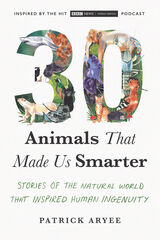 30 Animals That Made Us Smarter: Stories of the Natural World That Inspired Human Ingenuity
Patrick Aryee
Island Press, 2022 Did you know that mosquitoes’ mouthparts are helping to develop pain-free surgical needles? Who'd have thought that the humble mussel could inspire so many useful things, from plywood production to a “glue” that can cement the crowns on teeth? Or that the design of polar bear fur may one day help keep humans warm in space? In everything from fashion to architecture, medicine to transportation, it may surprise you how many extraordinary inventions have been inspired by the natural world.
Take the woodpecker as one incredible example. Woodpeckers can face up to 1,2000 Gs of force, but they’re protected from brain damage by the design of their beaks and skulls. These marvels of nature have inspired an array of cutting-edge ideas, from an advanced black box recorder for airplanes to an exceptionally strong bike helmet. In 30 Animals That Made Us Smarter, join wildlife biologist, TV host, and BBC podcaster Patrick Aryee as he tells stories of biomimicry, or innovations inspired by the natural world, which enrich our lives every day—and in some cases, save them.
With Aryee’s infectious curiosity and sense of wonder as inspiration, venture with us into the hidden world of biomimicry. 30 Animals That Made Us Smarter will reveal animals’ exceptional powers and change the way you look at the natural world forever.
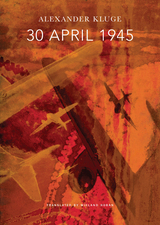 30 April 1945: The Day Hitler Shot Himself and Germany's Integration with the West Began
Alexander Kluge
Seagull Books, 2015 A reissue of Alexander Kluge's kaleidoscopic view of a historically important day and its effects on many people’s lives.
April 30, 1945, marked an end of sorts in the Third Reich. The last business day before a national holiday and then a series of transfers of power, April 30 was a day filled with contradictions and bewildering events that would forever define global history. It was on this day that while the Red Army occupied Berlin, Hitler committed suicide in his underground bunker, and, in San Francisco, the United Nations was being founded.
Alexander Kluge’s latest book, 30 April 1945, covers this single historic day and unravels its passing hours across the different theaters of the Second World War. Translated by Wieland Hoban, the book delves into the events happening around the world on one fateful day, including the life of a small German town occupied by American forces and the story of two SS officers stranded on the forsaken Kerguelen Islands in the South Indian Sea. Kluge is a master storyteller, and as he unfolds these disparate tales, one unavoidable question surfaces: What is the appropriate reaction to the total upheaval of the status quo?
Presented here with an afterword by Reinhard Jirgl, translated by Iain Galbraith, 30 April 1945 is a riveting collection of lives turned upside down by the deadliest war in history. The collective experiences Kluge paints here are jarring, poignant, and imbued with meaning. Seventy years later, we can still see our own reflections on the upheaval of a single day in 1945.
 30 Walks in New Jersey
Kevin Dann
Rutgers University Press, 1992 Windswept beaches, rolling hill country, steep slopes, broad green river valleys, beaver ponds, dense cedar swamps, spectacular water falls, iron forges, and tranquil villages are all part of New Jersey's landscape.There is no better way to appreciate and understand this landscape than to walk through it. For years, hikers have treasured Kevin Dann's 25 Walks in New Jersey. Now Kevin Dann and Gordon Miller expanded that classic guide. In addition to revising and updating the original twenty-five walks, they have included five new walks in Salem, Bridgeton, Burlington, Allaire State Park, and Moore's Beach.
The thirty walks range from two-hour jaunts over level terrain to more taxing full-day hikes. Walks in the Kittatiny Ridge, the Highlands, the Piedmont, the Delaware River Valley, the Pinelands, Cape May, along the Atlantic Coast, and communities of historical interest are all included. For each trip, the authors guide the walker along the way, pointing out distinctive rock formations, plant communities, and wildlife as well as noting the ways human activity has shaped the landscape. They provide clear maps to the route, directions, and hours of operation.
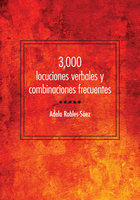 3,000 locuciones verbales y combinaciones frecuentes
Adela Robles-Sáez
Georgetown University Press, 2011 This extensive Spanish language reference explains the logic behind more than 3,000 frequently used verb phrases and combinations that make Spanish speech sound native. Each entry includes a definition of the phrase including its register, synonyms, antonyms, complementary expressions, grammatical patterns, and examples of how the combinations are used in easy and difficult structures. Most entries also point out other factors to be taken into account, such as whether an expression is to be used in isolation, after explaining a cause, or if it shouldn't be used at the beginning of a sentence. The book presents generative patterns for combinations based on conceptual metaphors and grammar structures, details families of expressions as separate charts, and contains an index by complement. Featuring a wide range of varieties of Spanish, this volume includes both peninsular and New World Spanish and draws on both written and spoken corpora. Based on sound research in cognitive linguistics and written entirely in Spanish, this valuable reference will be useful to advanced students of Spanish, teachers of Spanish, translators, and writers.
Sample Entry
ABUNDAR
Abundar en detalles: Ofrecer mucha información. Esta expresión se utiliza en contextos neutros o formales. En forma negativa (no abundar en detalles) se usa para expresar de manera irónica que alguien no quiere ofrecer tanta información como necesitamos. S: El informe sobre el golpe de estado
V: abunda
CR: en detalles sobre la intervención de la CIA El estudio abunda en detalles estadísticos sobre la inmigración, pero no explica ni
sus causas ni sus consecuencias. La testigo reconoció que era amante del acusado, pero no abundó en detalles sobre su relación. Contraste:
Informal: Paquita llegó a casa borracha y con un ojo morado. Explicó a su marido que se había caído y nada más.
Formal: La víctima llegó a su casa intoxicada y con señales de abuso físico. Explicó, sin abundar en detalles, que eran resultado de una caída. Expresiones relacionadas:
1. Entrar en detalles (frecuentemente no entrar en detalles): Discutir un tema en profundidad. ‘No entrar’ significa quedarse fuera, por lo tanto, no entrar en detalles significa no explicar ningún detalle, mientras que no abundar en detalles significa hablar poco sobre un tema. El estudio abunda en detalles estadísticos sobre la inmigración, pero no explica ni sus causas ni sus consecuencias. *El estudio entra en detalles estadísticos sobre la inmigración, pero no explica ni sus causas ni sus consecuencias. Hasta ahora hemos tratado el tema de la absorción de este mineral de manera superficial. Ahora entraremos en detalles. *Hasta ahora hemos tratado el tema de la absorción de este mineral de manera superficial. Ahora abundaremos en detalles.
 The 30-Minute Fitness Solution: A Four-Step Plan for Women of All Ages
JoAnn Manson, M.D. and Patricia Amend, M.A.
Harvard University Press, 2001 Just 30 minutes a day of moderate exercise--even walking--can save your life. This is the powerful message that Dr. JoAnn Manson--of the lead investigators of both the Women's Health Initiative and the Nurses' Health Study--and her coauthor Patricia Amend want to send to American women.
Regardless of the barriers you may face--too busy, too tired, too "down," or too old--with this four-step practical plan you'll find the excuses falling away and a happier, healthier self emerging. This book offers not only state-of-the-art information from recent medical research but step-by-step instructions on how to get started and maintain a physically active lifestyle. The authors will help you choose a "core" activity that doesn't disrupt your daily life. Then they will show you how to measure your fitness level at the start, how to monitor your progress over time, and how to reward yourself for your efforts. These four simple steps to fitness will work no matter who you are--25 or 75, harried mother or overworked professional (or both), in good health or living with a chronic disease.
The authors have included a clearly illustrated program of stretching and strength-training exercises; sensible activities for women with health concerns; an intelligent weight-loss plan; guidelines for selecting home exercise equipment and choosing a health club; and much more. With over 100 illustrations, questionnaires, and checklists, this book has everything you need to feel good, look better, and live longer, starting today--it's all just 30 minutes away.
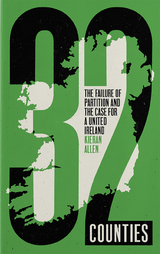 32 Counties: The Failure of Partition and the Case for a United Ireland
Kieran Allen
Pluto Press, 2021 'This is Irish history seen anew, from below, bristling with practical lessons for working-class struggle today' - Eamonn McCann
The 32 counties of Ireland were divided through imperial terror and gerrymandering. Partition was borne from a Tory strategy to defend the British Empire and has spawned a 'carnival of reaction' in Irish politics ever since. Over the last 100 years, conservative forces have dominated both states offering religious identity as a diversion from economic failures and inequality.
Through a sharp analysis of the history of partition, Kieran Allen rejects the view that the 'two cultures' of Catholic and Protestant communities lock people into permanent antagonism. Instead, the sectarian states have kept its citizens divided through political and economic measures like austerity, competition for reduced services and low wages.
Overturning conventional narratives, 32 Counties evokes the tradition of James Connolly and calls for an Irish unity movement from below to forge the North and the Republic into a secular, socialist and united Ireland.
33 Lessons on Capital: Reading Marx Politically
Harry Cleaver
Pluto Press, 2019 This book provides an up-to-date reading of Capital Volume I, emphasizing the relevance of Marx's analysis to everyday twenty-first century struggles.
Harry Cleaver's treatise outlines and critiques Marx's analysis chapter by chapter. His unique interpretation of Marx's labour theory of value reveals how every theoretical category of Capital designates aspects of class struggle in ways that help us resist and escape them. At the same time, while rooted within the tradition of workerism, he understands the working class to include not only the industrial proletariat but also unwaged peasants, housewives, children and students.
A challenge to scholars and an invaluable resource for students and activists today.
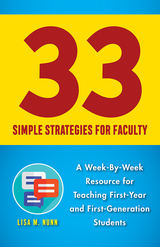 33 Simple Strategies for Faculty: A Week-by-Week Resource for Teaching First-Year and First-Generation Students
Nunn, Lisa M
Rutgers University Press, 2019 Winner of the 2020 Scholarly Contributions to Teaching and Learning Award from the American Sociological Association
Many students struggle with the transition from high school to university life. This is especially true of first-generation college students, who are often unfamiliar with the norms and expectations of academia. College professors usually want to help, but many feel overwhelmed by the prospect of making extra time in their already hectic schedules to meet with these struggling students.
33 Simple Strategies for Faculty is a guidebook filled with practical solutions to this problem. It gives college faculty concrete exercises and tools they can use both inside and outside of the classroom to effectively bolster the academic success and wellbeing of their students. To devise these strategies, educational sociologist Lisa M. Nunn talked with a variety of first-year college students, learning what they find baffling and frustrating about their classes, as well as what they love about their professors’ teaching.
Combining student perspectives with the latest research on bridging the academic achievement gap, she shows how professors can make a difference by spending as little as fifteen minutes a week helping their students acculturate to college life. Whether you are a new faculty member or a tenured professor, you are sure to find 33 Simple Strategies for Faculty to be an invaluable resource.
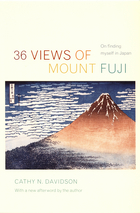 36 Views of Mount Fuji: On Finding Myself in Japan
Cathy N. Davidson
Duke University Press, 2006 In 1980 Cathy N. Davidson traveled to Japan to teach English at a leading all-women’s university. It was the first of many journeys and the beginning of a deep and abiding fascination. In this extraordinary book, Davidson depicts a series of intimate moments and small epiphanies that together make up a panoramic view of Japan. With wit, candor, and a lover’s keen eye, she tells captivating stories—from that of a Buddhist funeral laden with ritual to an exhilarating evening spent touring the “Floating World,” the sensual demimonde in which salaryman meets geisha and the normal rules are suspended. On a remote island inhabited by one of the last matriarchal societies in the world, a disconcertingly down-to-earth priestess leads her to the heart of a sacred grove. And she spends a few unforgettable weeks in a quasi-Victorian residence called the Practice House, where, until recently, Japanese women were taught American customs so that they would make proper wives for husbands who might be stationed abroad. In an afterword new to this edition, Davidson tells of a poignant trip back to Japan in 2005 to visit friends who had remade their lives after the Great Hanshin Earthquake of 1995, which had devastated the city of Kobe, as well as the small town where Davidson had lived and the university where she taught. 36 Views of Mount Fuji not only transforms our image of Japan, it offers a stirring look at the very nature of culture and identity. Often funny, sometimes liltingly sad, it is as intimate and irresistible as a long-awaited letter from a good friend.
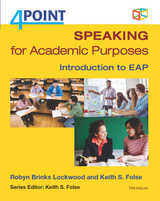 4 Point Speaking for Academic Purposes: Introduction to EAP
Robyn Brinks Lockwood and Keith S. Folse
University of Michigan Press, 2017
The 4 Point series is designed for English language learners whose primary goal is to succeed in an academic setting. Academic English learners need skills-based books that focus on reading, listening, and speaking, as well as the two primary language bases of vocabulary and grammar. The ultimate goal is to help your students improve these skills and earn a 4.0 (GPA).
The Introduction to English for Academic Purposes (EAP) level is designed for students in academic programs who need a more general introduction to authentic academic content. The discrete skills volumes are designed for programs and courses that want to more intensively focus on key strategies and authentic academic content in one skill area.
Each 4 Point volume covers academic skills while providing reinforcement and systematic recycling of key vocabulary issues and further exposure to grammar issues. These volumes focus very heavily on vocabulary because language learners know that they are way behind their native-speaker counterparts when it comes to vocabulary. Each book highlights key vocabulary items, including individual words, compound words, phrasal verbs, short phrases, idioms, metaphors, collocations and longer set lexical phrases.
Speaking for Academic Purposes is an introductory textbook containing English for Academic Purposes content. Each unit includes activities to strengthen a range of speaking skills, notably: understanding classroom discourse, using academic language functions, recognizing signal words and phrases, and synthesizing information. These activities are presented within the context of one field of academic study (Architecture, Marketing, Earth Science, U.S. History, Chemistry, and Fine Arts) per unit.
Unique to this speaking text are six videos showing common student interactions. Access to the videos is free.
Each unit includes three academic speaking strategies (including one specific to making presentations) and tasks that involve participating in group discussions, interacting with native speakers, and making a presentation. The goal is to provide students with a variety of strategies/tools to master academic situations in which they need to participate.
42nd Street
Edited by Rocco Fumento; Tino T. Balio, Series Editor
University of Wisconsin Press, 1980 This screenplay of 42nd Street, along with Rocco Fumento's thorough and engrossing introduction, takes the reader behind the scenes to see how the Warners studio took a dismal novel and, working within severe financial constraints brought on by the Great Depression, turned out a smash musical hit.
42nd Street is a watershed film, one that resuscitated the Hollywood musical during troubled times. Yet 42nd Street wasn't merely a Depression tonic, its multiple plot line was half-comic, half-serious. It was a fast-paced, energetic, and the first musical not to shrink away from the fact that a Depression was going on. The film is an odd, and oddly successful, fusion of the real with the fantastic.
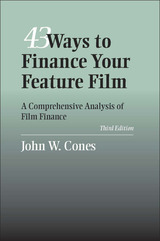 43 Ways to Finance Your Feature Film: A Comprehensive Analysis of Film Finance
John W. Cones
Southern Illinois University Press, 2008 John W. Cones has updated his now classic 43 Ways toFinance Your Feature Film: A Comprehensive Analysis of Film Finance with a substantially reorganized and expanded third edition. An essential reference guide for film professionals on every side of film financing, 43 Ways answers the question that every filmmaker and producer ultimately faces, the issue that can make or break any venture into the film industry: How do I finance my feature film? The third edition includes updated information and coverage of new options for financing. In his clear and concise style and with expertise amassed over his nearly twenty years of experience in the film finance industry, Cones breaks financing options down into six main areas: gifts and grants, investor financing, domestic government subsidies and tax incentive programs, lender financing, international finance options, and studio or industry financing. Beginning with the forms of financing most likely to be accessible to independent feature film producers, Cones proceeds to other forms that become increasingly available as the producer’s career matures. As an objective adviser, Cones provides specific, concise information regarding the many possible financing strategies and lists the distinct pros and cons of each strategy. This guide covers the options for film financing in rich detail so that even first-time producers and filmmakers will be able to make educated and informed decisions about the best approaches to financing their films. An extensive bibliography contains additional information about each form of film finance. Cones also counters much of the bad advice being provided by pseudoprofessional film finance consultants and points out scams that may separate unwary film producers from their money. Although the book focuses on financing feature films, much of its information is relevant to the financing of other kinds of projects, such as short films, documentaries, videos, and multimedia and theatrical endeavors. Anyone considering making or investing in a feature film will be well served by this practical and helpful guide.
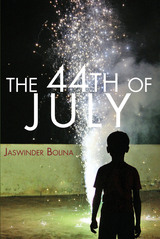 The 44th of July
Jaswinder Bolina
Omnidawn, 2019 This is a book about Americans. Not the ones brunching in Park Slope or farming in Wranglers or trading synergies in a boardroom; they are not executives or socialites. They are not the salt of the earth. Nor are they huddled masses yearning to breathe free. These are the others of the everyday, the Americans no one sees. These are the brown and bland ones who understand the good, tough money in working a double, who know which end of a joint to hit. They can find Karachi on a map. They know a shortcut to Ikea. They can land a punchline. These are their poems.
In The 44th of July, Jaswinder Bolina offers bracing and often humorous reflections on American culture through the lens of an alienated outsider at a deliberately uncomfortable distance that puts the oddities of the culture on full display. Exploring the nuances of life in an America that doesn’t treat you as one of its own, yet whose benefits still touch your life, these exquisitely crafted poems sing in a kaleidoscopic collaging of language the mundane, yet surreal experience of being in between a cultural heritage of migration and poverty and daily life in a discriminatory yet prosperous nation. Both complicit in global capitalism and victims of the inequality that makes it possible, these are the Americans who are caught in a system with no clear place for them. Bolina opens the space to include the excluded, bringing voice and embodied consciousness to experiences that are essential to Americanness, but get removed from view in the chasms between self and other, immigrant and citizen.
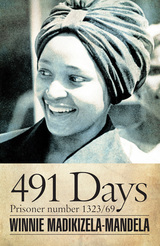 491 Days: Prisoner Number 1323/69
Winnie Madikizela-Mandela
Ohio University Press, 2014 On a freezing winter’s night, a few hours before dawn on May 12, 1969, South African security police stormed the Soweto home of Winnie Madikizela-Mandela, activist and wife of the imprisoned Nelson Mandela, and arrested her in the presence of her two young daughters, then aged nine and ten. Rounded up in a group of other antiapartheid activists under Section 6 of the Terrorism Act, designed for the security police to hold and interrogate people for as long as they wanted, she was taken away. She had no idea where they were taking her or what would happen to her children. For Winnie Mandela, this was the start of 491 days of detention and two trials. Forty-one years after Winnie Mandela’s release on September 14, 1970, Greta Soggot, the widow of one of the defense attorneys from the 1969–70 trials, handed her a stack of papers that included a journal and notes she had written while in detention, most of the time in solitary confinement. Their reappearance brought back to Winnie vivid and horrifying memories and uncovered for the rest of us a unique and personal slice of South Africa’s history. 491 Days: Prisoner Number 1323/69 shares with the world Winnie Mandela’s moving and compelling journal along with some of the letters written between several affected parties at the time, including Winnie and Nelson Mandela, himself then a prisoner on Robben Island for nearly seven years. Readers will gain insight into the brutality she experienced and her depths of despair, as well as her resilience and defiance under extreme pressure. This young wife and mother emerged after 491 days in detention unbowed and determined to continue the struggle for freedom.
4QInstruction
Matthew J. Goff
SBL Press, 2013 The wisdom tradition of ancient Israel, represented in the Hebrew Bible by Proverbs, Job, and Ecclesiastes and in the Apocrypha by Ben Sira and the Wisdom of Solomon, is also well-attested in the texts from Qumran. 4QInstruction (1Q26, 4Q415–418, 4Q423), the largest wisdom text of the Dead Sea Scrolls, is considered a sapiential text primarily because of its explicit and insistent pedagogical nature. To make this significant wisdom text more widely available, this volume offers a critical edition, translation, and commentary on the main fragments of 4QInstruction. It examines particular texts of 4QInstruction as well as broader issues, including its date, genre, main themes, and place in Second Temple Judaism. Finally, in order to contextualize this pivotal work, 4QInstruction’s relationship to the sapiential and apocalyptic traditions is also explored.
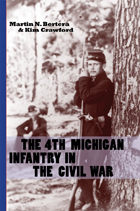 The 4th Michigan Infantry in the Civil War
Martin N. Bertera
Michigan State University Press, 2010 This fascinating narrative tells the story of a remarkable regiment at the center of Civil War history. The real-life adventure emerges from accounts of scores of soldiers who served in the 4th Michigan Infantry, gleaned from their diaries, letters, and memoirs; the reports of their officers and commanders; the stories by journalists who covered them; and the recollections of the Confederates who fought against them. The book includes tales of life in camp, portraying the Michigan soldiers as everyday people—recounting their practical jokes, illnesses, political views, personality conflicts, comradeship, and courage.
The book also tells the true story of what happened to Colonel Harrison Jeffords and the 4th Michigan when the regiment marched into John Rose's wheat field on a sweltering early July evening at Gettysburg. Beyond the myths and romanticized newspaper stories, this account presents the historical evidence of Jeffords's heroic, yet tragic, hand-to-hand struggle for his regiment's U.S. flag.
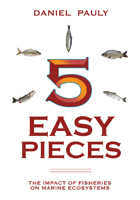 5 Easy Pieces: The Impact of Fisheries on Marine Ecosystems
Daniel Pauly
Island Press, 2010 5 Easy Pieces features five contributions, originally published in Nature and Science, demonstrating the massive impacts of modern industrial fisheries on marine ecosystems. Initially published over an eight-year period, from 1995 to 2003, these articles illustrate a transition in scientific thought—from the initially-contested realization that the crisis of fisheries and their underlying ocean ecosystems was, in fact, global to its broad acceptance by mainstream scientific and public opinion.
Daniel Pauly, a well-known fisheries expert who was a co-author of all five articles, presents each original article here and surrounds it with a rich array of contemporary comments, many of which led Pauly and his colleagues to further study. In addition, Pauly documents how popular media reported on the articles and their findings. By doing so, he demonstrates how science evolves. In one chapter, for example, the popular media pick up a contribution and use Pauly’s conclusions to contextualize current political disputes; in another, what might be seen as nitpicking by fellow scientists leads Pauly and his colleagues to strengthen their case that commercial fishing is endangering the global marine ecosystem. This structure also allows readers to see how scientists’ interactions with the popular media can shape the reception of their own, sometimes controversial, scientific studies.
In an epilog, Pauly reflects on the ways that scientific consensus emerges from discussions both within and outside the scientific community.
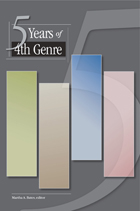 5 Years of 4th Genre
Martha Bates
Michigan State University Press, 2006 In 1999, Michigan State University Press launched Fourth Genre: Explorations in Creative Nonfiction, a journal that began with and has maintained a devotion to publishing notable, innovative work in nonfiction. The title reflects an intent to give nonfiction its due as a literary genre—to give writers of the 'fourth genre' a showcase for their work and to give readers a place to find the liveliest and most creative works in the form.
Given the genre's flexibility and expansiveness, journal editors Michael Steinberg and David Cooper have welcomed a variety of works— ranging from personal essays and memoirs to literary journalism and personal criticism. The essays are lyrical, self-interrogative, meditative, and reflective, as well as expository, analytical, exploratory, or whimsical. In short, Fourth Genre encourages a writer- to-reader conversation, one that explores the markers and boundaries of literary/creative nonfiction.
Since its inaugural issue, contributors have earned many literary awards: 5 Notable Essays of the Year (Best American Essay); the Lowell Thomas Travel Journalism Award; Notable Essay of the Year (Best American Travel Writing); and 4 Pushcart Prizes. Five Years of 4th Genre is a celebration of this significant literary journal. Culling a selection of some of the most creative of Fourth Genre’s first five years—the Pushcart winners are here, as well as those essays that are unique, those that tell us something new, those that startle us, and those that touch our hearts —this volume presents a representative sampling.
 The 50% American: Immigration and National Identity in an Age of Terror
Stanley A. Renshon
Georgetown University Press, 2005 The United States is the only nation in the world that allows its citizens to hold one or more foreign citizenships, vote in another nation's elections, run for or be appointed to office in another country, and join the armed forces even of a nation with interests hostile to those of the U.S. while retaining their citizenship. These policies reinforce the often already strong emotional, political, and economic ties today's immigrants retain to their home countries. Yet few studies have addressed what dual citizenship means for the United States as a nation and the integration of immigrants into the American national community. Is it possible to reconcile two different nationalities, cultures, and psychologies? How can we honor immigrants' sense of identity without threatening American national identity? What do Americans have a right to expect of immigrants and what do they have a right to expect of Americans? In The 50% American political psychologist Stanley Renshon offers unique insight into the political and national ramifications of personal loyalties. Arguing that the glue that binds this country together is a psychological force—patriotism—he explains why powerful emotional attachments are critical to American civic process and how they make possible united action in times of crisis. In an age of terrorism, the idea that we are all Americans regardless of our differences is more than a credo; it is essential to our national security. Comprehensive in scope, this book examines recent immigration trends, tracing the assimilation process that immigrants to the United States undergo and describing how federal, state, and local governments have dealt with volatile issues such as language requirements, voting rights, and schooling. Renshon turns a critical eye to the challenges posed over the past four decades by multiculturalism, cultural conflict, and global citizenship and puts forth a comprehensive proposal for reforming dual citizenship and helping immigrants and citizens alike become more integrated into the American national community.
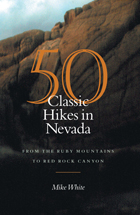 50 Classic Hikes In Nevada: From The Ruby Mountains To Red Rock Canyon
Mike White
University of Nevada Press, 2006 Nevada boasts some of the most diverse and beautiful landscapes in North America and is rich in trails that embrace the state’s scenic, geologic, and historic resources. Mike White, renowned outdoors writer and instructor, now offers a guide to fifty of the best Nevada hikes, ranging across the entire state from the Mojave Desert to the Sierra Nevada, from sagebrush basins to the alpine heights of the Ruby Mountains. Here are hikes for every taste and level of fitness, including outings suitable for families with small children and full-scale assaults on challenging peaks. Each hike is described in terms of its route and special features, and includes a map and elevation profile. The book also offers information about the geology, wildlife, plants, history, and weather features of Nevada, as well as helpful directions to ensure safe and comfortable travel in Nevada’s rugged and isolated backcountry. This is an indispensable guide for anyone seeking enjoyable adventures in some of the country’s most spectacular natural regions.
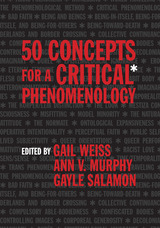 50 Concepts for a Critical Phenomenology
Edited by Gail Weiss, Ann V. Murphy, and Gayle Salamon
Northwestern University Press, 2020 Phenomenology, the philosophical method that seeks to uncover the taken-for-granted presuppositions, habits, and norms that structure everyday experience, is increasingly framed by ethical and political concerns. Critical phenomenology foregrounds experiences of marginalization, oppression, and power in order to identify and transform common experiences of injustice that render “the familiar” a site of oppression for many. In Fifty Concepts for a Critical Phenomenology, leading scholars present fresh readings of classic phenomenological topics and introduce newer concepts developed by feminist theorists, critical race theorists, disability theorists, and queer and trans theorists that capture aspects of lived experience that have traditionally been neglected. By centering historically marginalized perspectives, the chapters in this book breathe new life into the phenomenological tradition and reveal its ethical, social, and political promise. This volume will be an invaluable resource for teaching and research in continental philosophy; feminist, gender, and sexuality studies; critical race theory; disability studies; cultural studies; and critical theory more generally.
 50+ Library Services: Innovation in Action
Diantha Dow Schull
American Library Association, 2013 Some of the most engaged and frequent users of public libraries are over the age of 50. They may also be the most misunderstood. As Baby Boomers continue to swell their ranks, the behavior, interests, and information needs of this demographic have changed dramatically, and Schull's new book offers the keys to reshaping library services for the new generations of active older adults. A must-read for library educators, library directors, and any information professional working in a community setting, this important book - Analyzes key societal trends, such as longer lifespans and improved population health, and their implications for libraries' work with this demographic
- Profiles Leading-Edge States and Beacon Libraries from across the nation at the forefront of institutional change
- Discusses issues such as creativity, health, financial literacy, life planning, and intergenerational activities from the 50+ perspective, while showing how libraries can position themselves as essential centers for learning, encore careers, and community engagement
- Spotlights best practices that can be adapted for any setting, including samples of hundreds of projects and proposals that illustrate new approaches to 50+ policies, staffing, programs, services, partnerships, and communications
The wisdom and insight contained in this book can help make the library a center for positive aging.
 The 50 Most Extreme Places in Our Solar System
David Baker and Todd Ratcliff
Harvard University Press, 2010 The extreme events that we hear about daily—hurricanes, earthquakes, tsunamis, and volcanic eruptions—are extreme in purely human terms, in the devastation they do. But this book moves our understanding of the extreme into extraterrestrial dimensions and gives us an awe-inspiring sense of what our solar system at its utmost can do. Martian dust devils taller than Mount Everest. A hurricane that lasts over 340 years. Volcanoes with “lava” colder than Antarctica. Hail made of diamonds. Here, as the authors say, the “WOW” factor is restored to our understanding of scientific discovery, as we witness the grandeur and the weirdness that inspire researchers to dig deeper and go ever farther into the mysteries of the universe.
The 50 Most Extreme Places in Our Solar System combines a fascination with natural disasters and the mesmerizing allure of outer space to take readers on a journey that will forever change the way they view our solar system. Full of dazzling photographs from NASA’s most recent observations, this book explores extreme regions on Earth and beyond—giant turbulent storms, explosive volcanoes, and the possibility of life surviving in harsh conditions.
More than a collection of facts, the book conveys the dynamism of science as a process of exploration and discovery. As they amuse and entertain, David Baker and Todd Ratcliff, two experts in planetary science, highlight recent developments and unresolved mysteries and strive, at every turn, to answer that important scientific question: “Why?”
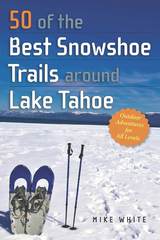 50 of the Best Snowshoe Trails Around Lake Tahoe
Mike White
University of Nevada Press, 2018 Come winter, Lake Tahoe’s trails, mountains, and shores shed their hikers and transform under a white blanket of snow into a serene winter wonderland. From towering snowy vistas, frozen subalpine lakes, lofty summits, and beautiful tree canopies, Lake Tahoe is one of America’s favorite winter playgrounds—with some of the most beautiful and invigorating views in the world. 50 of the Best Snowshoe Trails Around Tahoe offers snowshoers of all levels and experience a wide-range of excursions—from flat and easy to steep and strenuous. It includes a wide range of snowshoe routes such as Mt. Rose, Carson Pass, Emerald Bay, Fallen Leaf Lake, Highway 89, Truckee and Donner Pass. Features include: - Fifty distinct routes with directions to trailheads, detailed trip descriptions, and topographic maps
- Forty-five stunning photographs of popular trails, landscapes, and lake views
- Easy-to-read headings to provide key information on trail difficulty, distance, elevation, avalanche risk, facilities, managing agencies, highlights, lowlights, and more.
- A wide-range of outings for snowshoers of all abilities
- Recommendations on where to grab a hot drink, enjoy a hearty meal, or to snuggle up for a cozy overnight stay
- Tips on everything from proper clothing and footwear, equipment checklists, pre-hike warm-ups, sanitation, dog-friendly trails, and permit requirements
Whether you are an amateur explorer or a winter adventure enthusiast, this comprehensive guidebook has everything you need to explore the winter playgrounds surrounding Lake Tahoe.
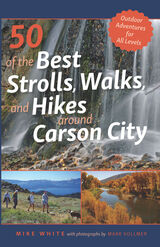 50 of the Best Strolls, Walks, and Hikes Around Carson City
Mike White
University of Nevada Press, 2020 One of the area’s foremost experts on the outdoors, Mike White, author of 50 of the Best Strolls, Walks, and Hikes Around Reno, returns with a new guidebook dedicated to Carson City and its surrounding areas in northern Nevada. With over three hundred days of sunshine a year, this capital city’s parks, trails, lakes, and soaring peaks provide the perfect attractions for residents and visitors alike. This guide provides readers with the most precise information for a wide range of detailed paths and trails throughout the greater Carson City region and includes interesting sidebars about human and natural history for each trip.
From Virginia City and the Carson River on the east to the Sierra Nevada mountains to the west, this comprehensive guidebook offers the most complete guide for walkers, joggers, and hikers. Whether you are looking for a short and easy stroll on a city path or an extended hike along the Tahoe Rim Trail, this is your all-inclusive resource for your next outdoor adventure.
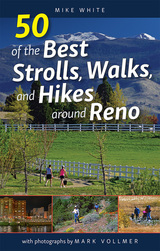 50 of the Best Strolls, Walks, and Hikes around Reno
Mike White
University of Nevada Press, 2017 Reno, Nevada is one of the best communities in the nation for outdoor recreational opportunities. With over three hundred days of sunshine a year, the weather beckons residents and visitors alike to step outside and enjoy a casual stroll in a city park, a stiff climb to the top of one of the area’s surrounding mountains, or just about anything in between. White offers the most complete guide for walkers, joggers, runners, and hikers to the best paths and trails in the greater Reno-Sparks region. This guide provides readers the most complete and detailed information for each excursion, from the Truckee River corridor to the Northern Valleys, including lakes, parks, trails, and mountains. Whether you are looking for a short and easy stroll on a paved path along one of the city’s greenbelts, or an extended hike into the mountains of the Mount Rose wilderness, this is your all-inclusive resource. White is one of the area’s foremost experts on the outdoors, and he includes interesting sidebars about human and natural history for each trip. This is a guide for anyone who enjoys a stroll, walk, or hike in and around Northern Nevada’s premier outdoor playgrounds.
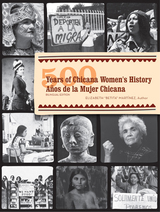 500 Years of Chicana Women's History / 500 Años de la Mujer Chicana: Bilingual Edition
Martínez, Elizabeth "
Rutgers University Press, 2008 Named the 2009 AAUP Best of the Best - Outstanding Book Distinction
The history of Mexican Americans spans more than five centuries and varies from region to region across the United States. Yet most of our history books devote at most a chapter to Chicano history, with even less attention to the story of Chicanas.
500 Years of Chicana Women’s History offers a powerful antidote to this omission with a vivid, pictorial account of struggle and survival, resilience and achievement, discrimination and identity. The bilingual text, along with hundreds of photos and other images, ranges from female-centered stories of pre-Columbian Mexico to profiles of contemporary social justice activists, labor leaders, youth organizers, artists, and environmentalists, among others. With a distinguished, seventeen-member advisory board, the book presents a remarkable combination of scholarship and youthful appeal.
In the section on jobs held by Mexicanas under U.S. rule in the 1800s, for example, readers learn about flamboyant Doña Tules, who owned a popular gambling saloon in Santa Fe, and Eulalia Arrilla de Pérez, a respected curandera (healer) in the San Diego area. Also covered are the “repatriation” campaigns” of the Midwest during the Depression that deported both adults and children, 75 percent of whom were U.S.–born and knew nothing of Mexico. Other stories include those of the garment, laundry, and cannery worker strikes, told from the perspective of Chicanas on the ground.
From the women who fought and died in the Mexican Revolution to those marching with their young children today for immigrant rights, every story draws inspiration. Like the editor’s previous book, 500 Years of Chicano History (still in print after 30 years), this thoroughly enriching view of Chicana women’s history promises to become a classic.
 5000 Years of Popular Culture: Popular Culture before Printing
Fred E.H. Schroeder
University of Wisconsin Press, 1980 This collection of insightful essays by outstanding artists, anthropologists, historians, classicists and humanists was developed to broaden the study of popular culture and to provide instances of original and innovative interdisciplinary approaches.
Its first purpose is to broaden the study of popular culture which is too often regarded in the academic world as the entertainment and leisure time activities of the 20th century. Second, the collection gives recognition to the fact that a number of disciplines have been investigating popular phenomena on different fronts, and it is designed to bring examples of these disciplines together under the common rubric of “popular culture.” Related to this is a third purpose of providing instances of original and innovative interdisciplinary approaches. Last, the collection should be a worthwhile contribution to the component disciplines as well as to the study of popular culture.
500,000 Azaleas: The Selected Poems of Efraín Huerta
Efraín Huerta
Northwestern University Press, 2001 In verses that fuse highly original imagery with exuberant rhythms, Efraín Huerta probes the cultures of both Mexico and "el Norte," from the impact of racism in Mississippi to political corruption in Mexico. Since he demanded for life and art the same freedom he demanded for politics, his poetry is often erotic. His poems are passionate outcries to love and justice, characterized by original metaphors and an acerbic wit that earned him the nickname "Crocodile."
 53 Ready-to-Use Kawaii Craft Projects
Ellyssa Kroski
American Library Association, 2020 In her new book Kroski, bestselling enthusiast of makerspaces, cosplay, and geek culture in libraries, has gathered creative and crafty librarians to share their most popular Kawaii programs. Running the gamut in terms of cost and difficulty, this book’s 53 programs are sure to include many that will fit your budget, space, and skills. Just scan the estimated budget, age range, materials, equipment needs, and learning outcomes in each listing. Projects include - keychains with felt or 3D printing;
- slime squishies;
- 3D printed animal earrings;
- hosting a stuffed animal fashion show;
- monster emoji paper bookmarks;
- origami fortune cookies;
- buttons with anime or comic book art;
- crocheted coffee cozy or puppy nose warmer;
- tiny top hats with laser-cut felt cameos; and
- how to Kawaii-ify a planner.
What’s more, the plentiful suggestions for “next projects” scattered throughout the book will help you keep the super-cute fun going!
57 Octaves Below Middle C
Kevin McIlvoy
Four Way Books, 2017 A hybrid collection comprised of short stories, flash fiction, and prose poems, the works in 57 Octaves Below Middle C enact the dilemma of self-forgetting. This book is for any reader who hears the states of dissonance that are disturbing and natural aspects of the human comedy.
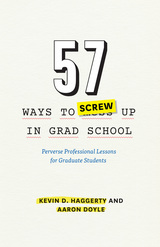 57 Ways to Screw Up in Grad School: Perverse Professional Lessons for Graduate Students
Kevin D. Haggerty and Aaron Doyle
University of Chicago Press, 2015 Don’t think about why you’re applying. Select a topic for entirely strategic reasons. Choose the coolest supervisor. Write only to deadlines. Expect people to hold your hand. Become “that” student.
When it comes to a masters or PhD program, most graduate students don’t deliberately set out to fail. Yet, of the nearly 500,000 people who start a graduate program each year, up to half will never complete their degree. Books abound on acing the admissions process, but there is little on what to do once the acceptance letter arrives. Veteran graduate directors Kevin D. Haggerty and Aaron Doyle have set out to demystify the world of advanced education. Taking a wry, frank approach, they explain the common mistakes that can trip up a new graduate student and lay out practical advice about how to avoid the pitfalls. Along the way they relate stories from their decades of mentorship and even share some slip-ups from their own grad experiences.
The litany of foul-ups is organized by theme and covers the grad school experience from beginning to end: selecting the university and program, interacting with advisors and fellow students, balancing personal and scholarly lives, navigating a thesis, and creating a life after academia. Although the tone is engagingly tongue-in-cheek, the lessons are crucial to anyone attending or contemplating grad school. 57 Ways to Screw Up in Grad School allows you to learn from others’ mistakes rather than making them yourself.
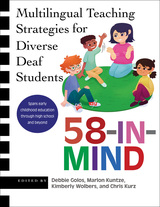 58-IN-MIND: Multilingual Teaching Strategies for Diverse Deaf Students
Debbie Golos
Gallaudet University Press, 2024 A highly practical and engaging resource for current and future teachers, 58-IN-MIND describes and demonstrates theoretically-driven, research-based, and classroom-tested best practices for using American Sign Language and English in instruction across the curriculum. The multilingual and multimodal instructional strategies presented here are embedded in approaches that aid learning and foster well-being. This book will support teachers in creating meaningful educational experiences for Deaf students in all grades, from early childhood education through high school.
Each chapter is written by a team of researchers and P–12 teachers with at least one Deaf coauthor. With seventy-five percent of the authors being Deaf, this is the first teaching methods book to harness the expertise of Deaf professionals at this level, highlighting their vital role in Deaf education and in shaping inclusive and effective learning environments. This book meets the need for a resource that recognizes the diversity of Deaf students by creating space in the classroom to honor their home/heritage languages, cultures, races, genders, abilities, hearing levels, and other multiple and intersecting identities. Written in a conversational tone, the book includes core recommendations for instruction of the targeted subject area, examples of key strategies, lessons and real stories from those working in the field, suggestions for practice, and recommended resources.
“58-IN-MIND” in the title refers to the version of the ASL sign "stick" that is made on the forehead, which is equivalent to the English idiom “to stick in one's mind.” As in, when students learn in a culturally responsive manner, the learning is likely to stick. The title also alludes indirectly to the collective aspirations of the chapter authors that the practices discussed in the book will also stick in the readers’ minds, and thus have a transformative impact on the way Deaf students are taught.
5G Wireless Technologies
Angeliki Alexiou
The Institution of Engineering and Technology, 2017 Mobile data traffic is expected to exceed traffic from wired devices in the next couple of years. This emerging future will be empowered by revolutionary 5G radio network technologies with a focus on application-driven connectivity, transparently deployed over various technologies, infrastructures, users and devices to realise the vision of 'the Internet of Everything'. This book presents a roadmap of 5G, from advanced radio technologies to innovative resource management approaches and novel network architectures and system concepts.
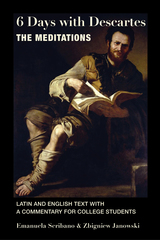 6 Days with Descartes: The Meditations, Latin and English Text with a Commentary for College Students
Rene Descartes
St. Augustine's Press, 2019
This new edition of Descartes’ Meditations by Zbigniew Janowski, wrote extensively on Descartes and 17th c. philosophy, was prepared with the first-year college student in mind. unlike all existing editions in english, which contain bare text of the Meditations, the novelty of this edition is that it includes a short commentary to each meditation, in which the editors help the reader follow Descartes’ steps and arguments.
In addition to their brief commentaries, the author also included short footnotes to the books and articles by contemporary Cartesian specialists who discuss in greater detail specific questions and problems which the text of the Meditations raises. In doing so, the author hopes to familiarize students with authors and titles of major works on Descartes, and with on-going scholarly controversies which this masterpiece of modern thought still inspires
Six Days with Descartes: The Meditations, Latin and English Text with a Commentary for College Students can also serve as a helpful tool for young and less experienced teachers of philosophy.
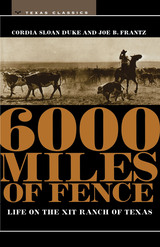 6000 Miles of Fence
By Cordia Sloan Duke
University of Texas Press, 1961 The fabulous XIT Ranch has been celebrated in song, story, and serious history. This book of reminiscences of old XIT cowmen puts on record the everyday life of the individuals who made the ranch run. Their forthright, yet picturesque, discussion of ranching hardships and dangers dissipates Hollywood and TV glamorizing. They relate in honest cowboy language what actually happened inside the XIT's 6,000 miles of fence. Cordia Sloan Duke, wife of an XIT division manager, Robert L. Duke, many years ago realized that only those who had experienced ranch life could depict it with deep understanding. As the young wife of a rising young ranch hand, she kept in her apron pocket a notebook and pencil, recording all manner of interesting details as they caught her attention. This diary was the nucleus for the present book. Conceiving of an account of life on the XIT as presented by XIT cowboys, Mrs. Duke set about drawing from reticent, sometimes reluctant, ranch hands the impressions of the XIT (occasionally written down by their more literate wives or daughters) which they had retained through the years. Cordia Sloan Duke and Joe B. Frantz have organized the reminiscences around key aspects of ranch life, retaining the language of the cow hands.
 6+1 Proposals for Journalism: Navigating Converging Pressures
Edited by Chrysi Dagoula and Sofia Iordanidou
Intellect Books, 2022 An appraisal of key areas that pose obstacles to journalism’s progression.
In 2003, Shayne Bowman and Chris Willis wrote that “journalism is in the process of redefining itself, adjusting to the disruptive forces surrounding it.” Almost two decades later, discussions surrounding journalism and its future have not shifted as much as one would expect. The ensuing years have seen massive changes in the media landscape, great leaps in technological developments, financial crises, and the emergence of social media platforms, to name a few examples. It could be argued that we still share the same concerns.
This book is a dialogue, with each chapter highlighting threats to journalism’s future and pointing to direct proposals, indicating the steps needed to safeguard and enhance journalism. Issues in the industry that need to be addressed include current employment conditions, the dominance of web giants over crowdfunding, the lack of collaboration between professionals and academia, subpar media literacy, and elements of media regulation.
 63 Ready-to-Use Maker Projects
Ellyssa Kroski
American Library Association, 2017 This new compilation from editor and maker Kroski spotlights a multitude of creative projects that you can tailor for your own library. Librarians and makers from across the country present projects as fun as an upcycled fashion show, as practical as Bluetooth speakers, and as mischievous as a catapult. Included are projects for artists, sewers, videographers, coders, and engineers. The handy reference format will help you quickly identify the estimated costs, materials, and equipment; and because several projects don’t even require a dedicated makerspace, every library can join in. Inside you’ll find how-to guidance for projects like - a foam rocket launcher;
- stop-motion animation with 3D print characters;
- found-object robots;
- glowing ghost marionettes;
- Arduino eTextiles;
- magnetic slime;
- yarn painting;
- fidget flannels;
- an LED brooch; and
- cardboard sculpture.
With takeaways like origami tea lights or a t-shirt tote bag, your patrons will be sure to remember how much fun your library can be.
6G: Evolution or Revolution?: A converged view of cellular, Wi-Fi, computing and communication
Peter Smyth
The Institution of Engineering and Technology, 2024 There are numerous potential paths toward achieving the 6G network and various factors that could define it. Written by three telecom industry experts, this book explores the opportunities and challenges surrounding the next generation of wireless communication technology. Will 6G build solely on the future evolution success of the 5G network, or will the delivery of 6G facilitate a revolution in technology and infrastructure with the convergence of fixed/mobile networks and collaboration with hyperscalers to help fund it?
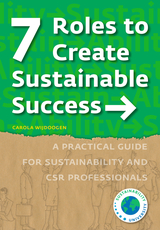 7 Roles to Create Sustainable Success: A Practical Guide for Sustainability and CSR Professionals
Carola Wijdoogen
Amsterdam University Press, 2020 Which roles and practices do you adopt to effectively guide businesses towards a sustainable future? And what skills and competencies do you need to establish sustainable transformation? In '7 Roles to Create Sustainable Success', Carola Wijdoogen shares the insights of 25 professionals around the world and her own experiences as Chief Sustainability Officer of Dutch Railways (NS), which she helped transform into a climate-neutral, circular and inclusive railway company. For example, the Netherlands was the first country in the world with trains running on 100% wind power.
The innovative science-based 7 Roles approach is explained using an excellent collection of practices and anecdotes from (among others) Kate Raworth ('Doughnut Economy') and CSOs of companies like Ingka Group, Levi Strauss & Co., Starbucks Coffee Company, Unilever Benelux, Microsoft, Kellogg Company, Interface Europe, KPN, Philips International B.V, DSM, AkzoNobel, Google, Tommy Hilfiger Global/PVH Europe, etc.
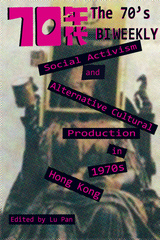 The 70's Biweekly: Social Activism and Alternative Cultural Production in 1970s Hong Kong
Edited by Lu Pan
Hong Kong University Press, 2023 An examination of the 1970s art and culture scene in Hong Kong through the lens of an independent youth magazine.
Taking The 70’s Biweekly—an independent youth publication in 1970s Hong Kong—as the main thread, this edited collection investigates an unexplored trajectory of Hong Kong’s cultural and artistic production in the 1970s. The 70’s Biweekly stands out from many other independent magazines with its unique blending of radical political theories, social activism, avant-garde art, and local literature. By taking the magazine as a node of social and cultural activism from and around which actions, debates, community, and artistic practices are formed, this book fills gaps in the study of how young Hong Kong cultural producers carved out an alternative space to speak out against established authorities.
Split into three parts, The 70’s Biweekly provides readers with a panoramic view of the political and cultural activism in Hong Kong during the 1970s, featuring writings on art and film, and interviews with former founders and contributors that reflect on how their participation led them to engage ideologically with their activism and community.
 7/7: The London Bombings, Islam and the Iraq War
Milan Rai
Pluto Press, 2006 This is the book Tony Blair doesn't want you to read about 7/7.
In February 2003, Tony Blair was warned by British intelligence that the invasion of Iraq would 'heighten' the risk of terrorism in Britain.
In July 2005, al-Qaeda struck in the heart of London. Despite the British Government's increasingly desperate attempts at denial, polls show that an overwhelming majority of people in Britain are convinced that there is a connection between the London bombings and the war on Iraq. A majority of Britons fault Tony Blair himself.
Using secret government documents declassified since the bombings, and leaks from British intelligence, Milan Rai exposes official deceit at the highest levels, and establishes the crucial role of British foreign policy in generating a home-grown version of al-Qaeda. Rai shows how an official report drawn up by the Home Office and Foreign Office in early 2004 identified 'foreign policy' - and the war in Iraq in particular - as a major cause of alienation among young British Muslims.
Examining the backgrounds of the 7/7 bombers, Milan Rai demonstrates that Islam is not to blame. Most importantly, the book shows us how to make sure that this never happens again -- and offers brief obituaries for the 52 people who lost their lives that day.
80 Years of Research at the Philips Natuurkundig Laboratorium (1914-1994): The Role of the Nat. Lab. at Philips
Marc J. de Vries
Amsterdam University Press, 2006
Since World War I, the Natuurkundig Laboratorium has been a crucial center of industrial research for Philips, one of the world’s largest electronics companies. In this study, Marc J. de Vries demonstrates how the history of the laboratory can help us understand important changes in the production and uses of technology in the twentieth century.
Breaking their study into three periods, each characterized by different research goals and approaches, the authors augment this general history with detailed case studies. The result will be of value to anyone studying the history and philosophy of technology.
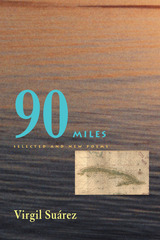 90 Miles: Selected And New Poems
Virgil Suarez
University of Pittsburgh Press, 2005
Ninety miles separate Cuba and Key West, Florida. Crossing that distance, thousands of Cubans have lost their lives. For Cuban American poet Virgil Suárez, that expanse of ocean represents the state of exile, which he has imaginatively bridged in over two decades of compelling poetry.
"Whatever isn't voiced in time drowns," Suárez writes in "River Fable," and the urgency to articulate the complex yearnings of the displaced marks all the poems collected here. 90 Miles contains the best work from Suárez's six previous collections: You Come Singing, Garabato, In the Republic of Longing, Palm Crows, Banyan, and Guide to the Blue Tongue, as well as important new poems.
At once meditative, confessional, and political, Suárez's work displays the refracted nature of a life of exile spent in Cuba, Spain, and the United States. Connected through memory and desire, Caribbean palms wave over American junk mail. Cuban mangos rot on Miami hospital trays. William Shakespeare visits Havana. And the ones who left Cuba plant trees of reconciliation with the ones who stayed.
Courageously prolific, Virgil Suárez is one of the most important Latino writers of his generation.
 900 Conclusions
Giovanni Pico della Mirandola
Harvard University Press, 2025 A groundbreaking edition of controversial theses proposed by the most famous philosopher of the Italian Renaissance.
Giovanni Pico della Mirandola (1463–1494), the most famous philosopher of the Italian Renaissance, had ambitions in line with his talents, especially in philosophical theology. His boldest venture urged Christians to save their souls with Jewish mysticism—Kabbalah—while also offering to debate anyone in Italy about his project. In 1486, he announced plans for a disputation in Rome on 900 theses, but Pope Innocent VIII quashed the event with an indictment for crimes against Christian orthodoxy.
Pico’s theses cited well-known scholastic authorities: Muslims like Ibn Rushd, Jews like Maimonides, and Christians like John Duns Scotus and Thomas Aquinas. But as Brian Copenhaver demonstrates in Nine Hundred Conclusions, many of Pico’s scholastic sources were filtered through a less renowned Thomist theologian named Jean Cabrol (Capreolus). Pico also sought to enrich Christian theology with newly available authorities from the Platonic and Pythagorean traditions as well as theosophical texts associated with ancient Orphism and Hermetism. Supreme among his authorities were theses taken from medieval Jewish Kabbalah, which Pico regarded as an angelic revelation and tried to appropriate for Christianity. The present volume is a ground-breaking contribution, containing a new critical edition of the Latin text along with a new translation into contemporary English, a detailed introduction, and a commentary discussing each of the 900 theses individually.
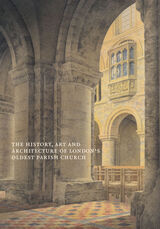 900 Years of St Bartholomew the Great: The History, Art and Architecture of London's Oldest Parish Church
Edited by Charlotte Gauthier
Paul Holberton Publishing, 2022 The most comprehensive, updated history of St. Bartholomew the Great, the oldest parish church in London, as it celebrates its nine-hundred-year anniversary. At the heart of the Smithfield area, with its pubs, restaurants, and market, is a church built when Henry I was King of England. Overlooking the fields where kings confronted rebellions, knights jousted, and heretics were burnt, St. Bartholomew’s Priory and Hospital played a central role in the history of medieval London. The tale of St. Bartholomew’s is one of survival and renewal. Not only has the priory hosted many of London’s most famous (such as a young Benjamin Franklin), but it has also miraculously survived the tumults of the Reformation, the Civil War, the Great Fire of 1666, and the bomb raids of World Wars I and II. Richly illustrated, 900 Years of St Bartholomew’s surveys the art, architecture, and deep historical significance of this enduring landmark.
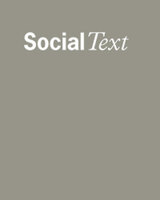 911 A Public Emergency?, Volume 20
Ella Shohat, Brent Edwards, Stefano Harney, Randy Martin, Timothy Mitchell, and Fred Moten, eds.
Duke University Press Since September 11, public discourse has often been framed in terms of absolutes: an age of innocence gives way to a present under siege, while the United States and its allies face off against the Axis of Evil. This special issue of Social Text aims to move beyond these binaries toward thoughtful analysis. The editors argue that the challenge for the Left is to develop an antiterrorism stance that acknowledges the legacy of U.S. trade and foreign policy as well as the diversity of the Muslim faith and the dangers presented by fundamentalism of all kinds. Examining the strengths and shortcomings of area, race, and gender studies in the search for understanding, this issue considers cross-cultural feminism as a means of combating terrorism; racial profiling of Muslims in the context of other racist logics; and the homogenization of dissent. The issue includes poetry, photographic work, and an article by Judith Butler on the discursive space surrounding the attacks of September 11. This impressive range of contributions questions the meaning and implications of the events of September 11 and their aftermath. Contributors. Muneer Ahmad, Meena Alexander, Lopamudra Basu, Judith Butler, Zillah Eisenstein, Stefano Harney, Randy Martin, Rosalind C. Morris, Fred Moten, Sandrine Nicoletta, Yigal Nizri, Jasbir K. Puar, Amit S. Rai, Ella Shohat, Ban Wang
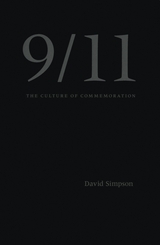 9/11: The Culture of Commemoration
David Simpson
University of Chicago Press, 2006 After the terrorist attacks of September 11, 2001, a general sense that the world was different—that nothing would ever be the same—settled upon a grieving nation; the events of that day were received as cataclysmic disruptions of an ordered world. Refuting this claim, David Simpson examines the complex and paradoxical character of American public discourse since that September morning, considering the ways the event has been aestheticized, exploited, and appropriated, while “Ground Zero” remains the contested site of an effort at adequate commemoration.
In 9/11, Simpson argues that elements of the conventional culture of mourning and remembrance—grieving the dead, summarizing their lives in obituaries, and erecting monuments in their memory—have been co-opted for political advantage. He also confronts those who labeled the event an “apocalypse,” condemning their exploitation of 9/11 for the defense of torture and war.
In four elegant chapters—two of which expand on essays originally published in the London Review of Books to great acclaim—Simpson analyzes the response to 9/11: the nationally syndicated “Portraits of Grief” obituaries in the New York Times; the debates over the rebuilding of the World Trade Center towers and the memorial design; the representation of American and Iraqi dead after the invasion of March 2003, along with the worldwide circulation of the Abu Ghraib torture photographs; and the urgent and largely ignored critique of homeland rhetoric from the domain of critical theory.
Calling for a sustained cultural and theoretical analysis, 9/11 is the first book of its kind to consider the events of that tragic day with a perspective so firmly grounded in the humanities and so persuasive about the contribution they can make to our understanding of its consequences.
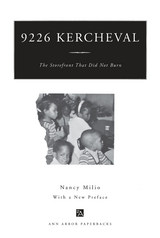 9226 Kercheval: The Storefront that Did Not Burn, With a New Preface
Nancy Milio
University of Michigan Press, 2000 "They make you feel like you're somebody..." The testimony of one black woman in Detroit's Lower Southeast Side ghetto, explaining what the storefront at 9226 Kercheval Street means to her. The storefront houses the Mom and Tots Neighborhood Center—a remarkable experiment in community health care, founded by a diminutive registered nurse named Nancy Milio and run by and for the people of the ghetto. This is the area that was literally burned down during the Detroit Riot of 1967. Not a proper location for a maternity and daycare center, according to many white professionals."These people ought to go away from their neighborhood so they can see how other people live... if we make it too easy for them, they'll never..."During the Riot, buildings on both sides of the Mom and Tots Center were fired and gutted. The Center was untouched. Why it was untouched is one of the implicit themes of 9226 Kercheval; as is the theme of struggle—struggle in the birth and development of a truly relevant health-care center, and struggle to define "health" in its broadest possible terms."Health is... opening, unfolding, from diffuseness towards coherence, simplicity toward complexity... toward wholeness."9226 Kercheval is both a documentary of how a new institution grew and a personal account of how a "social activist" was herself changed. It is the story—beautifully conceived and written—of the strengths of the so-called people of poverty. There is no other book like it.
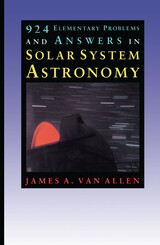 924 Elementary Problems and Answers in Solar System Astronomy
Van Allen, James A.
University of Iowa Press, 1993 This challenging collection of problems is organized into seven carefully crafted, thoughtful chapters on the Sun and the nature of the solar system; the motion of the planets; the Sun, Earth, and Moon; the sky as observed from the rotating, revolving Earth; other planets, their satellites, their rings; asteroids, comets, and meteoroids; and the radiations and telescopes. From question 1, "List characteristics of the solar system that are major clues in devising a hypothesis of its origin and evolution," through question 924, "Give a brief list of the contributions of radio and radar technologies in lunar and planetary astronomy," the problems range in difficulty from ones requiring only simple knowledge to ones requiring significant understanding and analysis. Many of the answers, in turn, illuminate the questions by providing basic explanations of the concepts involved. Pioneer 10 and 11 are now halfway to the edge of the solar system. All beginning and advanced students of astronomy and their instructors as well as all dedicated amateurs can join James Van Allen on this journey by exploring the questions and answers in this stimulating book.
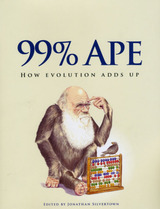 99% Ape: How Evolution Adds Up
Edited by Jonathan Silvertown
University of Chicago Press, 2009 In his lifetime, Charles Darwin was roundly mocked for suggesting that humans were descended from apes, and even in our own day, the teaching of evolution remains controversial. But in the century and a half since the publication of On the Origin of Species, our increasingly sophisticated understanding of genetics has borne out Darwin’s theory: humans share 99% of their genes with chimps (and many even with grapes!). 99% Ape offers an accessible, straightforward introduction to evolution, beginning with Darwin’s discoveries and continuing through the latest genetic discoveries. Edited by Jonathan Silvertown, the volume brings together experts in a variety of fields pertinent to evolution, from paleobiology to planetary science, comparative anatomy to zoology, and even—for a discussion of legal battles surrounding the teaching of evolution—law. Interwoven with these varied accounts of evolution and its impact are vignettes from Darwin’s life that illustrate the continuity of thought that links Darwin’s work to today’s cutting-edge research. Beautifully illustrated, 99% Ape is a perfect companion to the upcoming celebration of Darwin’s bicentennial and a bracing reminder of the important role evolution still has to play in our understanding of our origins—and our possible futures.
99 Fables
William March
University of Alabama Press, 2011 Superb stories, meaningful themes, and powerful effects
At the time of his death, the longest manuscript still in William March's possession was a collection of fables, which he had completed for the first time in 1938. While Company K, The Tallons, The Bad Seed, and all the rest were in progress, March culled and rewrote, polished and revised these fables, always finding them “too good to destroy,” yet never finding them a good venture for a commercial publisher. Now, posthumously, the collection appears in this book, and readers can enjoy the fabulous world of William March.
This is not to imply that it is a “pretty world.” The fables themselves are an immediate delight, and everyone will find many favorites among the 99. But in the end, March's view of the world is a hard one, and the morals, however charmingly expressed are bitter enough to rival the themes of his novels.
 99 Poets/1999: An International Poetics Symposium, Volume 26
Charles Bernstein
Duke University Press 99 Poets/1999 presents the work of ninety-nine poets in dialogue with one another across the divides of language, culture, and temperament. With contributions from the Americas, Eastern and Western Europe, the Middle East, Australia, New Zealand, and China, the volume features responses to questions posed by the guest editor Charles Bernstein—responses that range from historical to imaginary and from philosophical to poetic. Each poet was asked to ponder a series of questions: Is identity an important issue for your work, and, if so, in what sense? What do you see as the most urgent, yet insufficiently addressed or considered, issue or issues for poetry and poetics at this moment? Do you see your work in the context of a national state, or in the context of international capital, or in some other context? After years of exchange between the artists—through translations, readings, and visits—the result is a collection of unique and significant literary works, one that is richly suggestive for the future not only of poetry but of literary and cultural studies as well.
9XM Talking: WHA Radio and the Wisconsin Idea
Randall Davidson
University of Wisconsin Press, 2017 Randall Davidson provides a comprehensive history of the innovative work of Wisconsin's educational radio stations. Beginning with the first broadcast by experimental station 9XM at the University of Wisconsin, followed by WHA, through the state-owned affiliate WLBL, to the network of stations that in the years following WWII formed the Wisconsin Public Radio network, Davidson describes how, with homemade equipment and ideas developed from scratch, public radio became a tangible example of the Wisconsin Idea, bringing the educational riches of the university to all the state's residents. Marking the centennial year of Wisconsin Public Radio, this paperback edition includes a new foreword by Bill Siemering, National Public Radio's founding director of programming.
|
|
